The ultimutt flight: Virgin Australia set to launch Australia’s first-ever pets in cabin flights

Virgin Australia has announced plans to become Australia’s first airline to operate flights with pets allowed in the cabin.
Pet-lovers across Australia will be thrilled by the plans, which are subject to regulatory approval and expected to launch within 12 months.
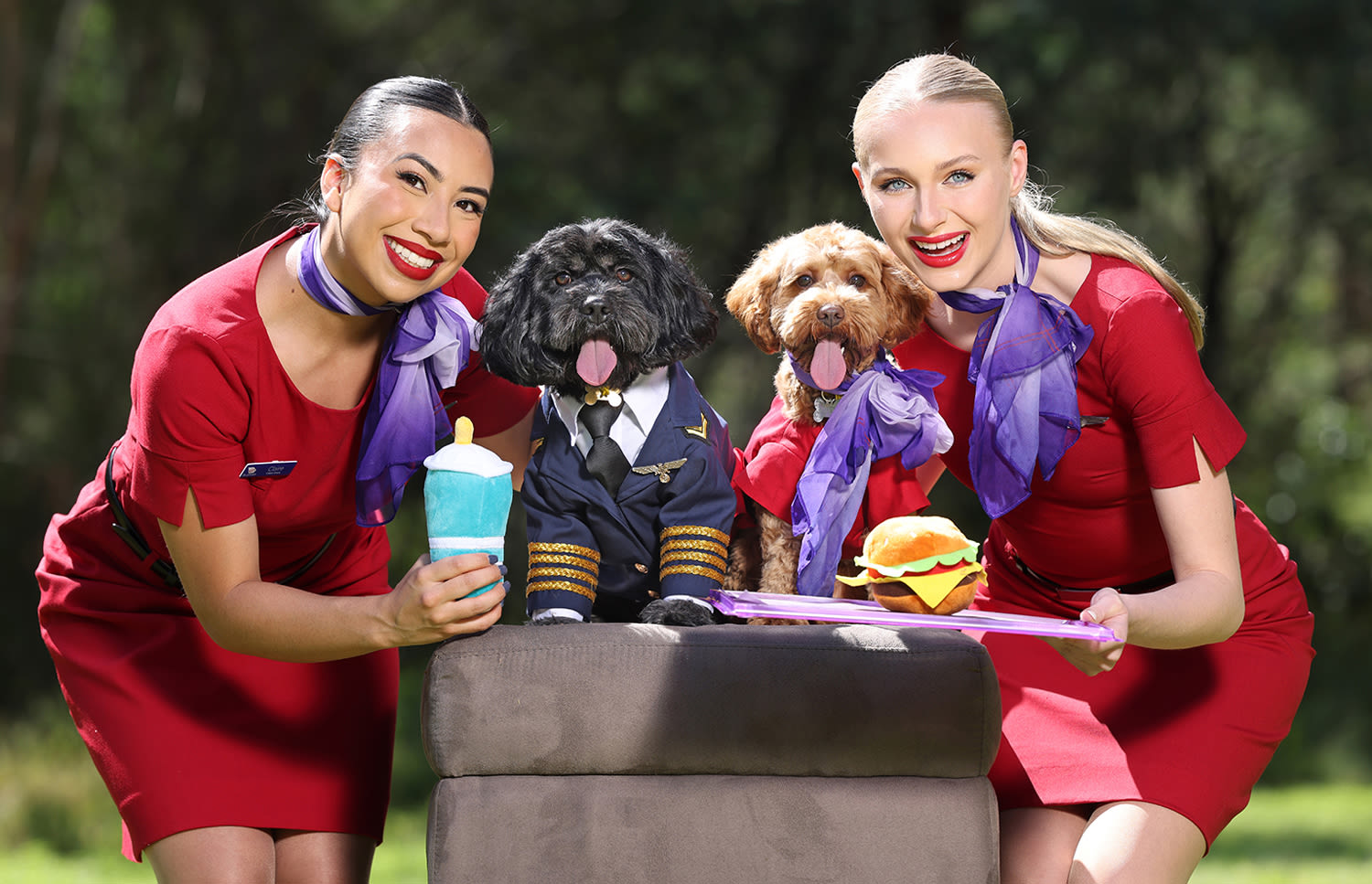
In a social media survey of Virgin Australia’s Facebook followers in 2021, 85% of people voted in favour of the airline launching pets in cabin flights. And more recent research by Virgin Australia confirmed that 70% of people would travel with their pet in the cabin, and 57% of those said they would fly more regularly if they could take their pet with them.
There will be limits for guests bringing a pet with them, incuding:
Only small cats and dogs will be allowed, and only on specific domestic routes
Pets will be restricted to a limited number of designated rows and will not be allowed to roam freely or sit on laps
Pets must be carried in a Virgin Australia-approved pet carried under the seat in front of the owner for the duration of the flight
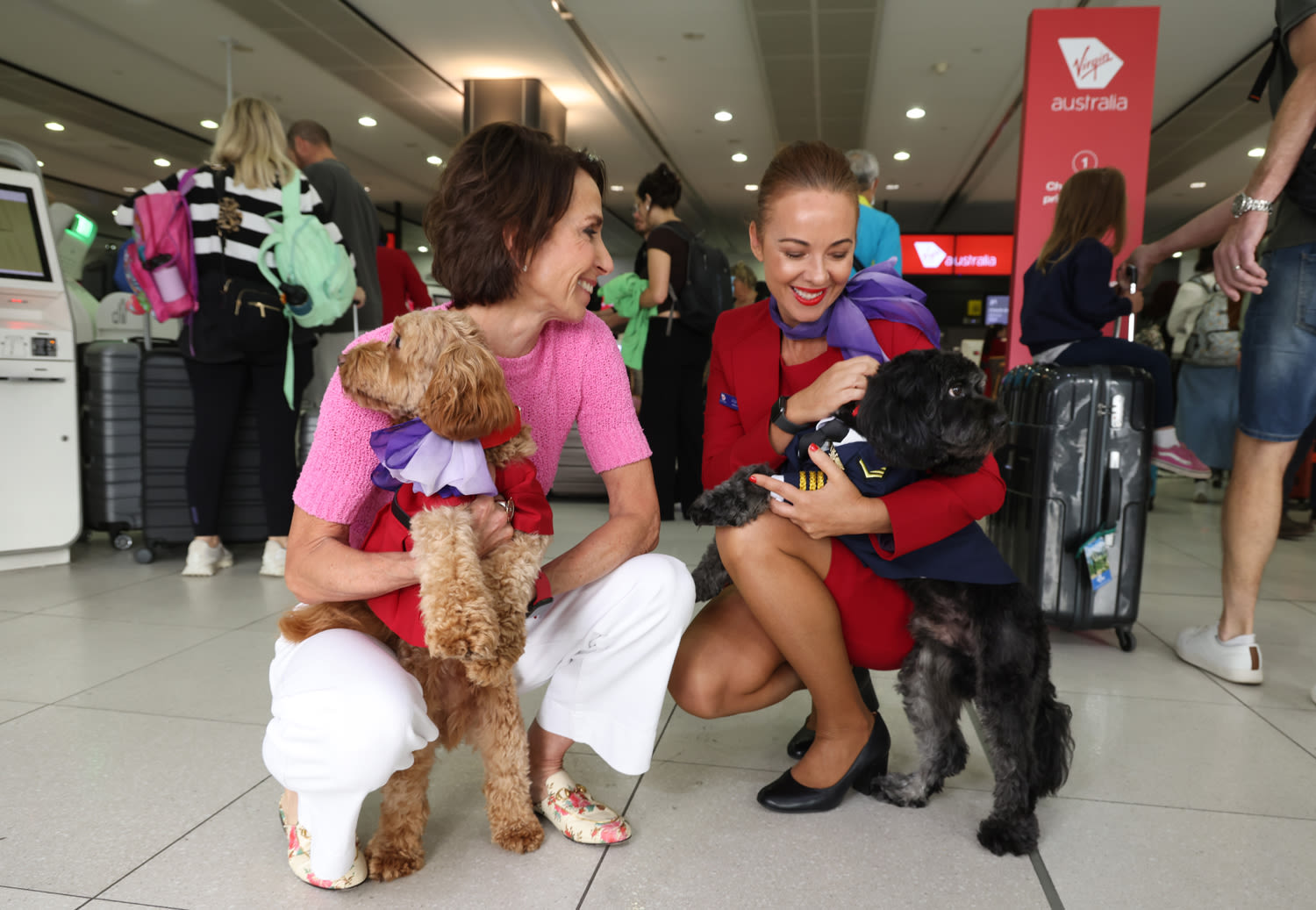
“Our love for animals has always been in the Virgin Australia DNA and we are excited at the prospect of taking off with Australia’s first-ever pets in cabin flights,” Virgin Australia CEO Jayne Hrdlicka said. “Overwhelmingly, our guests tell us they want to travel with their pets, and we are now on a journey to make that a reality. It’s something that commonly happens overseas and is proven to work well.”
Melbourne Airport CEO Lorie Argus added: “We’ve been investing significant effort into providing relief areas for assistance animals and these facilities have ample capacity to serve Virgin Australia’s new guests.
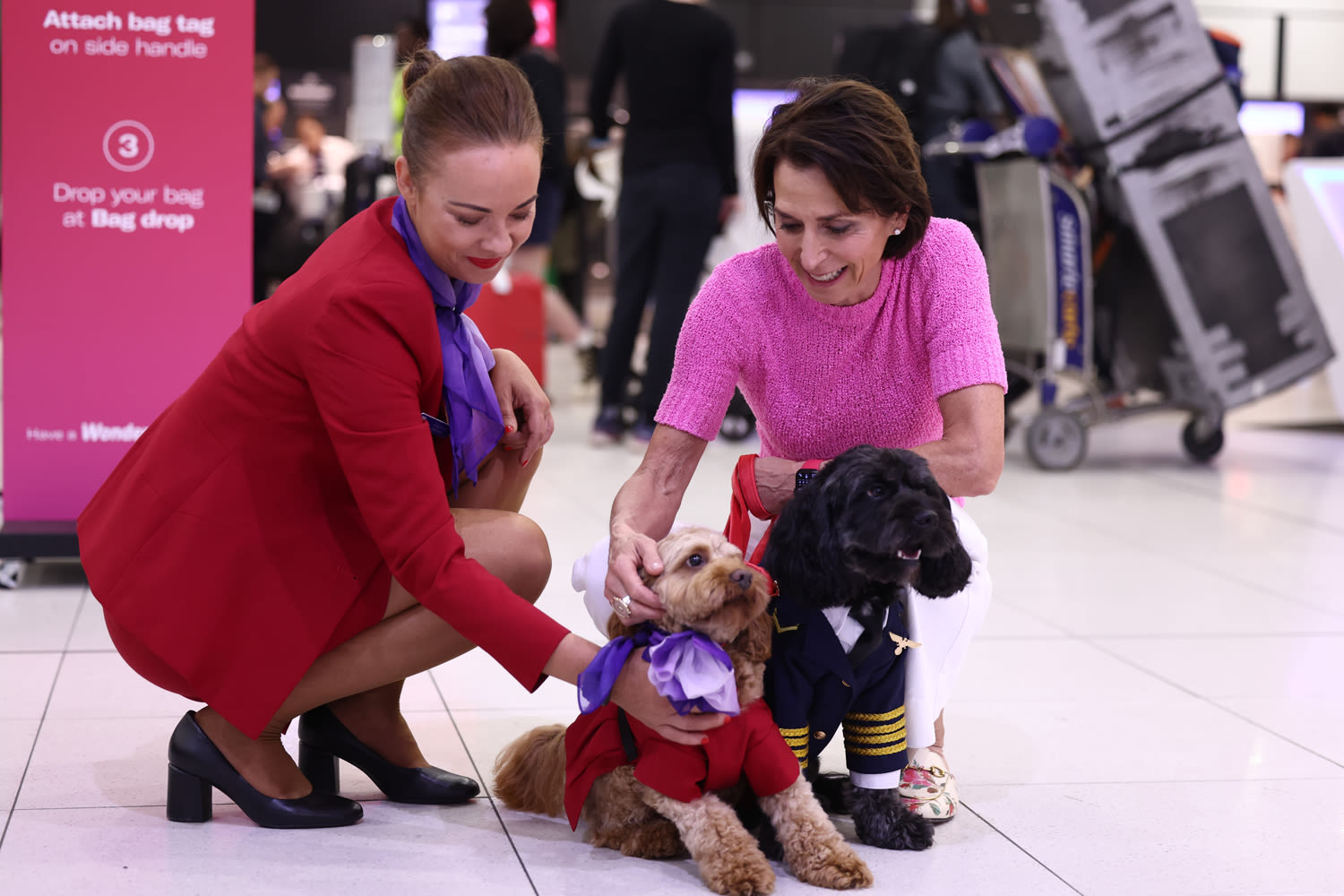
“Animals being carried on board Virgin Australia flights will be required to remain in their approved pet carriers at all other times within the terminal. We expect the pets in cabin concept will prove a popular offering and we look forward to working with Virgin Australia to make it a reality.”

No changes for assistance animals
Virgin Australia has confirmed that the proposed pets in cabin flights will not result in any change to approved assistance animals being able to travel in Virgin Australia aircraft cabins at no additional cost. The existing procedure for assessing the eligibility of these assistance animals to travel will also not change. And Virgin Australia will continue to offer pets to be transported as cargo through approved pet carrier services as this remains an important part of the airline’s offering.
Visit Virgin Australia to find out more.
- International edition
- Australia edition
- Europe edition
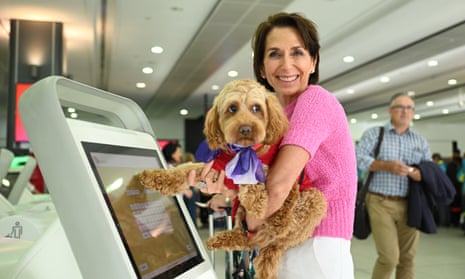
Who let the dogs on? Everything you need to know about Virgin Australia’s planned pets in cabins scheme
From confining animals to carriers to dealing with doggy business, how will the airline’s policy to let small cats and canines fly in plane cabins actually work?
- Follow our Australia news live blog for latest updates
- Get our morning and afternoon news emails , free app or daily news podcast
Virgin Australia’s announcement that it will allow small cats and dogs to fly at passengers’ feet may have triggered excitement among pet lovers eager for the future service, but there’s plenty of detail yet to be worked out – including one big elephant in the cabin.
In what will be an Australian first, Virgin have said they hope to launch the offering within 12 months, noting they will work out many of the finer details of the service as they say they need to wait for regulatory approval.
In the absence of such details, there’s no doubt plenty of travellers alarmed at the announcement will be thinking twice about booking a future flight with the airline until it becomes clear how it will deal with certain animal-related concerns.
After all, animals running loose on planes have had alarming and sometimes fatal consequences. In 2010, a small plane running short domestic routes in the Democratic Republic of Congo plummeted to the ground in a crash that killed 20 people, with the sole survivor later reporting the incident occurred after a crocodile ran loose on the aircraft.
Here’s everything we know about how Virgin Australia’s pets in the cabin scheme will work.
Sign up for Guardian Australia’s free morning and afternoon email newsletters for your daily news roundup
Which pets will be allowed?
Virgin Australia has said the pets in cabin service will be “limited to small cats and dogs”.
The airline hasn’t specified what “small” means.
Carriers in the United States that already have such schemes in places restrict certain breeds.
Will we be able to just walk (small) pets on to the plane?
No. The rules here have been strictly set out.
Pets must be carried in a Virgin Australia-approved pet carrier and placed under the seat in front of the owner for the duration of the flight. Taller travellers who already struggle with legroom may find it challenging.
So I can’t show off my beloved Rover to my fellow passengers?
Nope. In fact, only certain rows of seats on certain domestic flights will be eligible for pet owners wanting to use the service.
There is to be no sitting in laps, walking of pets down the aisles or taking them to the bathroom.
Then what happens if Rover needs to do his business mid-air?
This may be the question on everybody’s mind, but Virgin Australia have not yet been forthcoming with an answer. It’s understood they’re still figuring out the finer details of the scheme.
Moisture-absorbent mats have been used for animal droppings from service animals – which are already allowed in plane cabins.
What’s stopping this from turning plane cabins into feeling like a zoo?
It’s unclear what Virgin Australia’s plan is in the event of a barking fit, or what is to be done with a particularly odorous pets.
Will Virgin Australia really be allowed to do this?
There don’t appear to be any laws stopping any airline from allowing pets in cabins. In fact, Virgin’s expectation of needing regulatory approval could even be overly cautious.
after newsletter promotion
In 2021, Australia’s air regulator, the Civil Aviation Safety Authority (Casa), changed its rules so that airlines no longer require its explicit permission to carry animals. Pilots and airlines now have discretion, so long as its safe.
“They must consider how to restrain animals, effects on other passengers, not blocking exit rows, dealing with droppings/urine. The procedures for pets would be added to their operations manuals,” a Casa spokesperson said in 2021.
On Thursday, Casa released a statement: “The regulation places the responsibility on the operator and pilot in command of the aircraft for ensuring the safety of the flight when an animal is carried on an aircraft.”
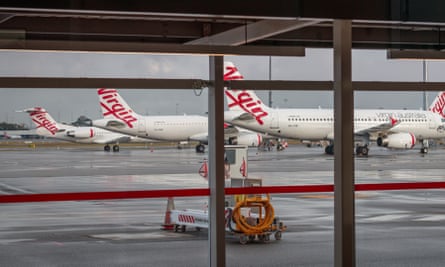
Why is Virgin Australia doing this now?
Because Australians want it as an option, the airline said.
Virgin Australia said that in a survey of its Facebook followers from 2021, 85% of respondents voted in favour of the airline launching pets in cabin flights.
In more recent research conducted by Virgin Australia with Australian pet owners, nearly 70% of respondents advised they would travel with their pet in the cabin, with 57% saying they would fly more regularly if the service was a reality.
In the increasingly tough battle to dent the dominance of Qantas (and its budget carrier Jetstar), which controls more than 60% of the domestic market, allowing pets in flight is one way for Virgin to set itself apart.
Currently, passengers can only fly with assistance animals in cabins on Australian airlines, and only if they require them. All other pets must fly in cargo holds. Airlines around the world, including Qantas , have faced criticism after animals travelling in the bellies of their planes died in transit.
The announcement also brings a positive story for Virgin Australia after the unexpected announcement their CEO, Jayne Hrdlicka, would be stepping down. The abrupt resignation led to media reports that she was axed by the airline’s private equity owners, Bain Capital, suggesting they were unhappy with her performance in the lead-up to the carrier’s much hyped re-listing on the stock exchange.
How have pets fares in cabins overseas?
In many overseas jurisdictions pets have been able to be carried in cabins for a fee for some time, with everything from pigs, miniature horses and ducks spotted on flights in the past.
The US has long allowed people to fly with emotional support animals as long as airlines allow it. Passengers have tried to bring a diverse range of creatures on board over the years as they tested the parameters of the rules.
In 2018, a woman was prevented from bringing a peacock on board a United Airlines flight, despite its owner being willing to pay an additional fare for her feathered friend.
But the scores of requests for unusual support animals eventually led the US transport department to ban all animals except dogs as service or emotional support animals in December 2020. Non-service animals can be taken on board in the US, with most airlines charging a fee and having limits for small pets only.
Some Middle Eastern airlines also allow falcons inside cabins and to have their own passports.
- Virgin Australia
- Airline industry
Most viewed
Five quick questions answered on Virgin Australia's plans to allow animals into flight cabins
Virgin Australia has announced it will be allowing small cats and dogs on specific domestic routes within the next 12 months.
The news has been met with a mixed response, with some commenters on social media excited to bring their pets on holidays, and others worried about allergies.
On the ABC News Facebook page, there were just as many "woo!" comments as there were people saying "no!"
"Cats being chased by dogs up and down the aisles now that's in-flight entertainment for the passengers," one user commented.
"About time we caught up with the rest of the world," another said.
A disappointed passenger wrote: "just perfect if you've flown Virgin Australia all your life and now you won't be able to as you're allergic to cats."
"This is not good. Kind of disgusting really. Now passengers have to put up with barking dogs on flights on top of everything else that comes with air travel," another person wrote.
These are some of your pressing questions answered:
How will they manage passengers with allergies?
Concerns about pet allergies was one of the most common comments after the announcement.
A Virgin Australia spokesperson said the company would be spending the next few months designing a safe proposition, with strict rules to manage this issue.
The spokesperson said pets would be limited to a small number of designated rows and would not be allowed to roam freely or sit on laps.
"Cabin airflow dynamics (air circulating from top to bottom), the renewal of cabin air 20-30 times per hour and use of hospital grade HEPA filtration in our aircraft (which captures greater than 99 per cent of airborne particles) mean the risk of allergy-triggering particles being circulated on-board is low," the spokesperson said.
They said the airline has robust systems in place for guests who have severe allergies to identify themselves, so those risks for these guests could be mitigated and arrangements put in place prior to travel.
"We also want to point out that pets in cabin flights work effectively overseas and we believe there's no reason why they won't work in Australia too," the spokesperson said.
How will animals cope with air travel?
RSPCA Australia Chief Science Officer, Suzie Fowler, said while there were risks associated with air travel for any type of pet, travelling in the cabin was generally a preferable option to pets travelling in the cargo with the right safeguards in place.
"If animals are in the cabin, owners or caregivers should ensure that their animals are under control, socialised to other animals and people and are calm and comfortable when travelling," Dr Fowler said.
"Travel can be stressful for animals, so we recommend that owners start preparing them for travel at least a few weeks beforehand.
"This includes getting them comfortable with their container (for example, by placing it somewhere they like to relax in the house and making it as inviting as possible, such as with your pet's favourite bedding, toys and treats) — hopefully meaning that they associate the container with good things and positive feelings.
"Ensure that any container complies with International Air Transport Association regulations, and that the animal has enough space to turn around normally while standing, to stand and sit erect, and to lie in a natural position."
Dr Fowler warned that some flat-faced breeds such as British Bulldogs, French Bulldogs, pugs, Boston terriers and Persian cats are at greater risk of heat stress. She said that owners should be aware of the increased risk that comes with air travel.
She recommended owners consult their vet prior to travel for an assessment of the animal's suitability for travel, regardless of whether it is in cargo or in the passenger cabin.
What steps are being taken to manage the extra mess and noise?
A Virgin Australia spokesperson said these finer details would be revealed in due course following appropriate stakeholder consultation and regulatory approval.
What they can confirm is that only small dogs and cats would be allowed on board, those which can fit into pet carriers stowed under the seat for the duration of the flight.
This means pets will not be allowed to sit on owners' laps.
In the United States, where animal travel in the cabin is generally allowed on domestic flights, most airlines recommend taking the pet to the bathroom before the flight, and using potty training pads as a back up.
American Airlines, for example, does not allow animals under 8 weeks to fly, restricts certain breeds, and allows pets only on flights under 12 hours.
Who is supporting the move?
The Civil Aviation Safety Authority (CASA) updated the rules on flying animals in December 2021 , giving airlines permission to bring pets into the cabins.
Virgin Australia is the of the major first airline groups to begin to bring the CASA change into practice.
Virgin conducted a survey in April 2023 with 643 Australian travellers, of which 426 were pet owners.
Of those pet owners, 286 said if it was allowed by the airline, they would most likely fly with their pets in the cabin "more than zero" times.
Additionally, 164 of those pet owners said they would take at least one extra return flight a year if they could fly with their pet in the cabin.
Dr Fowler said the RSPCA welcomed the announcement, as it supported policies that allow companion animals to travel, appropriately contained, in the aircraft with their owner or caregiver.
"We look forward to continuing to work with the airline industry to ensure that any transport of pets is done safely and with the animals' welfare front of mind," Dr Fowler said.
A Qantas spokesperson said there were no changes to their current policy for any Qantas Group flights, including Jetstar.
A Rex spokesperson said the airline was not ruling out the carriage of pets in the cabin. However, it had no immediate plans to introduce it, adding that assistance animals are still welcome in the cabin.
Will it cost more to bring your pets on board?
A spokesperson says Virgin Australia is still working on the finer details in regards to things like cost. However, they confirmed there would be a fee for guests to bring their pet onboard.
This cost does not apply to service animals.
In the US, United Airlines charges a $US125 ($190) fee to bring a pet on board.
- X (formerly Twitter)
- Air Transport Industry
- Large Animals
- Travel Health and Safety
- Travel and Tourism (Lifestyle and Leisure)
- United States
Virgin Australia to allow pets to fly in cabin in an Australian-first
Emily Murphy
Social Media Manager & Writer
08 March 2024
This time next year, you could be bringing your furry friends onboard specific Virgin Australia domestic flights.
Virgin Australia has announced its plans to become Australia’s first airline to allow pets onboard.
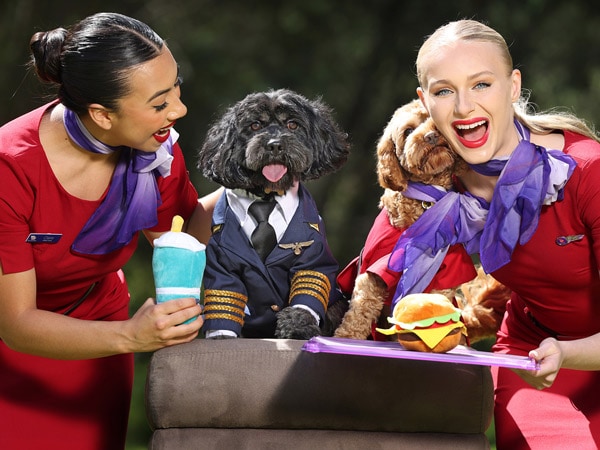
You could bring your furry friends on your next flight.
Responding to audience feedback from a 2021 survey where almost 70 per cent of respondents said they would travel with their pet in the cabin, Virgin Australia Group chief executive officer Jayne Hrdlicka said the company’s guests overwhelmingly want to travel with their pets.
“Our love for animals has always been in the Virgin Australia DNA and we are excited at the prospect of taking off with Australia’s first-ever pets in cabin flights,” Hrdlicka said.
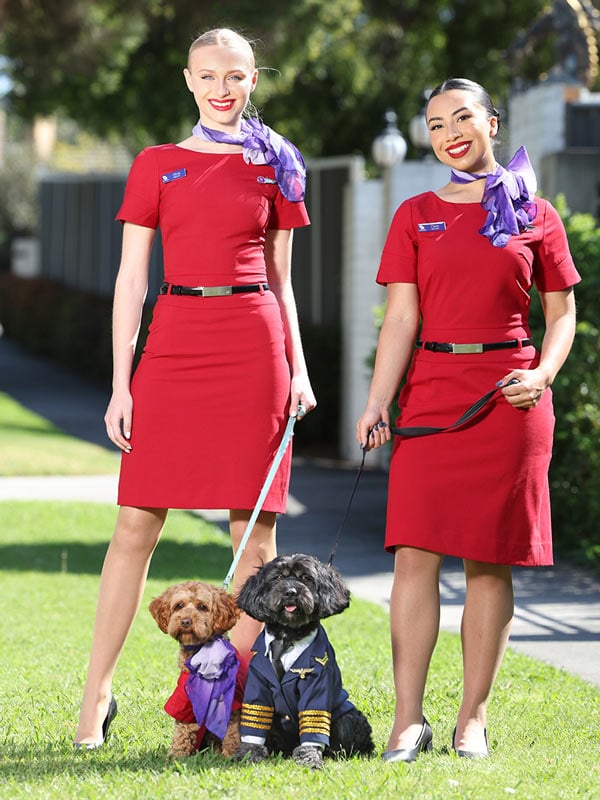
Almost 70 per cent of respondents said they would travel with their pet in the cabin.
There will be some limitations to the service, with only small cats and dogs allowed, and only on specific routes. The pets will also be restricted to a small number of designated rows, they won’t be able to roam freely or sit on their owner’s lap and they must be carried in a Virgin Australia-approved pet carrier, which must be kept under the seat in front of the owner for the duration of the flight.
“Animals being carried onboard Virgin Australia flights will be required to remain in their approved pet carriers at all other times within the terminal,” Melbourne Airport chief executive officer Lorie Argus said.
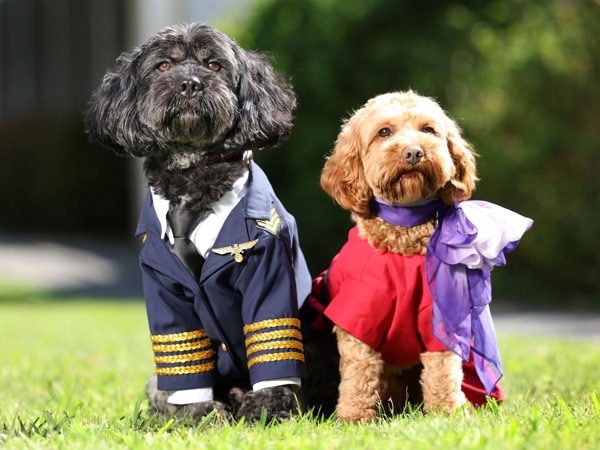
Only small cats and dogs will be allowed to use the service.
This new pets onboard service will not impact approved assistance animals being able to fly in the cabin of the aircraft at no additional cost. Pets will also still be able to be transported as cargo through approved pet carrier services.
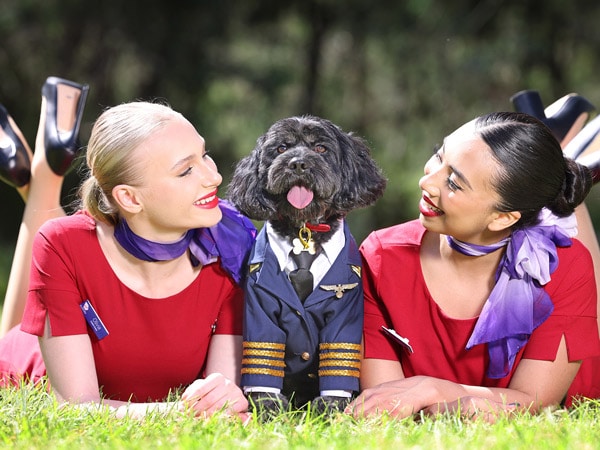
Assistance animals will be able to travel like normal.
With most major North American airlines offering a pets onboard service, Virgin Australia is taking a huge step in evolving Australian domestic flights.
“It’s something that commonly happens overseas and is proven to work well,” Hrdlicka said.
The service is expected to be implemented within 12 months, subject to regulatory approval.
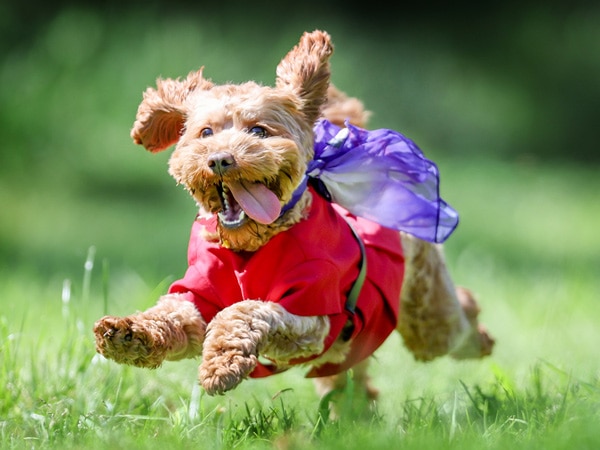
Virgin Australia is taking a huge step in evolving Australian domestic flights.
Will you be utilising Virgin Australia’s pets onboard service? We’d love to hear your thoughts!
Emily Murphy found her passion for writing at a young age and knew her future was in travel after she moved overseas solo at 18. Em loves to write about beautiful, under-the-radar destinations and anything that will ignite a desire in more people to explore the vastness and beauty that is Australia. She is a devoted bun mum and in her spare time you'll find her by the sea, reading a good book, binge-watching a TV show or exploring Sydney's dining scene.

LEAVE YOUR COMMENT
Cancel reply.
Save my name, email, and website in this browser for the next time I comment.
Comments (19)
Ridiculous. Time to change to another airline after 10 years as a Virgin customer.
What about passengers with Allergies? They all share the same Air, Will they be advised when booking that pets will be travelling?
I am 100% for pets being able to travel with their owners. I have spent time in the USA… and this plan works perfectly. It is barbaric to carry the pets in the luggage hold. I have experienced my pet being very ill and dehydrated after such an incident…and still carry the guilt after many years, to this day, Thank you for this opportunity to express my feelings on this subject. A salute to Virgin Airways! Marilyn.
How will they fit under the seat in front of you – I can’t even get my handbag under let alone a pet carrier?
NO way this should be implemented. Out of control in the USA. … and why should we copy them. The current system works ok. NO pets on planes. Incidentally, I love dogs and cats. John
Even though I have a savage allergy to cats, I’m all for it. Looking forward to traveling with Cleopatra, my support diamond python who would quite like to share a space with a cat as long as fluffy is less than two metres long.
Dogs will have to be very small indeed to fit in a carrier that has to be stowed under a seat. I doubt that the dogs in Virgin’s promo pics would fit, or be content to be stowed for hours in a tight cage.
I will never fly Virgin again
Hi Emily I am a dog lover however I and other members of my extended family, most have dogs, will definitely not be travelling on any airline that allows this. Having travelled overseas quite a few times we have never heard of this or encountered it in our air travels. It’s already very squeezy to place items under the seat in front and have room for your feet, let alone a pet in a cage. Don’t mind dogs/cats on a train as there is plenty of room and more circulating air. A big NO from us. regards Janice
I definitely disagree with allowing cats and dogs on flights and would not fly on such a flight.
Sorry. There is no way I will ever fly Virgin.
I won’t be flying with them & I love animals but this is ridiculous.
I think you should have a pets only flight with owners, so that customers that dislike dogs and cats can be offered an alternative flight. I would not be be happy to have animals in the cabin
We have travelled extensively in our lives and have only come across pets being allowed on board aircraft cabins once flying from Vienna to Stockholm. The pets were not allowed to stay with their owners in their seats but cabin staff placed them in cages in the front of the plane. They also only allow pets on short haul flights. Aircraft cabins are so small and cramped that we consider this practice totally unacceptable and very cruel for the animals. We would not fly with any airline that allows pets to travel with the passenger in their seat. This practice is just as bad as European restaurant and cafe customers being allowed to bring their dogs into the establishment. The world has gone completely bonkers in our opinion.
I will definitely be accessing this service for my very small dog depending on the flight routes.
Won’t be flying Virgin anymore then just imagine 6 dogs all barking at once!
Not for me Thank goodness Qantas has said no to pets in the main cabin
This makes me so happy and excited to potentially be able take my beautiful toy poodle girl on a flight with us. I would absolutely definitely use the pets onboard service with Virgin Australia.
At last, we’ll certainly make use of this! Haven’t flown for seven years as we wouldn’t leave our dog in a kennel, and she wouldn’t handle going in the hold of an aircraft as well as being separated from us. Drove the Nullarbor last year, but …. No more!
You might also like

The most amazing train journeys in Australia
These trains are so much more than a way to get from A to B. Lonely Planet has launched Amazing Train Journeys, a book spotlighting 60 incredible sce...

Australia’s top 10 towns for 2024 revealed
Here are 10 towns to take note of for your next weekend escape... Each year, Wotif pulls together intel from travel-savvy Aussies to spotlight trend...

The Aussie town crowned one of the world’s most welcoming places
Australians pride themselves on being an easy-going bunch. But there are some places where the locals just welcome you with open arms. If you love tr...

The top 10 Australian beaches of 2024
We love a beach here in Australia, and each year we eagerly await the official best beaches list so we know where to lay our towels. Nobody does beac...

18 ways to extend summer in 2024
Autumn may be at the doorstep, but these activities will keep you in a summer state of mind. Extending summer is all about capturing the feeling of t...

The 10 most famous outback icons to see once in your life
The outback icons you know and love. These renowned outback destinations are icons and on the national radar for a reason, but they still hold some r...

© Australian Traveller Media 2024. All rights reserved.
The pets you can (and can't) bring onboard under Virgin Australia's new plan
Please stow small bags and pets under the seat in front of you. virgin australia wants you to be able to bring your pet onboard flights — but at a cost, and under strict conditions..
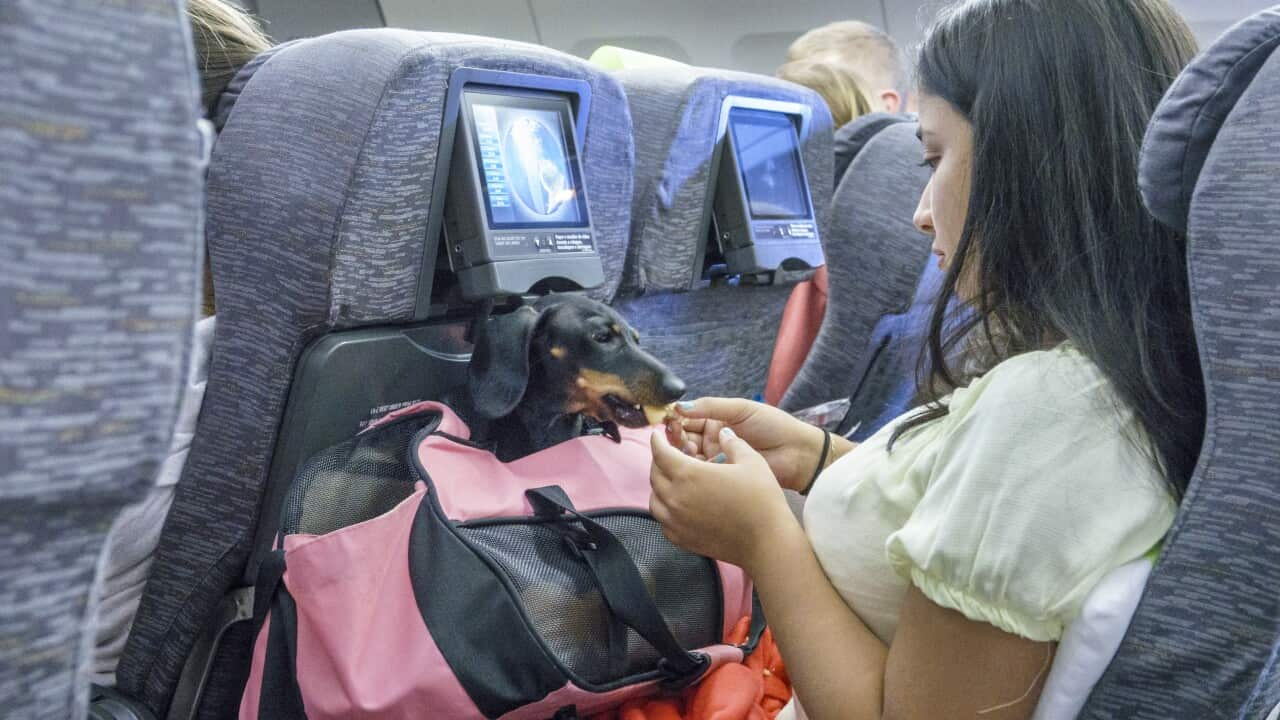
Virgin Australia wants to allow small cats and dogs in the cabin under strict conditions. Source: Getty / Jeff Greenberg/Universal Images Group

Share this with family and friends
Recommended for you

Policing at Mardi Gras events 'intensive and aggressive', report finds

Anthony Albanese criticises 'arrogant' Elon Musk's response to Australia's X takedown order

A new scam is circulating in Australia. One couple has lost more than $800,000

Australia Post will make a big delivery change next week. Here's how it will affect you
Postal service

Anthony Albanese says Bondi 'Bollard Man' can stay in Australia 'as long as he wants'
Sydney Stabbing

Nariman was forced to give up her career dream because of this 'discriminatory' requirement
Student finances

Clock is ticking: The Australian island facing an uncertain future
Immigration policy

Refugee who died defending others among six victims of Bondi stabbing attack
Get sbs news daily and direct to your inbox, sign up now for the latest news from australia and around the world direct to your inbox..
Morning (Mon–Fri)
Afternoon (Mon–Fri)
By subscribing, you agree to SBS’s terms of service and privacy policy including receiving email updates from SBS.
SBS World News
- Latest News
- Street Style
- Accessories
- Entertainment
- Sex & Relationships
- Health & Wellness
- Money & Career
- Food & Drink
- Home & Tech
- Beauty & Health
- Designer Fashion
- Homes To Love
- Home Beautiful
- Better Homes and Gardens
- Hard to Find
- Your Home and Garden
- Shop Your Home & Garden
- Now to Love
- Now to Love NZ
- That's Life
- Women's Weekly
- Women's Weekly Food
- NZ Woman's Weekly Food
- Gourmet Traveller
- Bounty Parents
- marie claire
- Beauty Heaven
- Beauty Crew
- LIFE & CULTURE
- DISCOUNT CODES
- Sustainability
Virgin Australia Is Letting Your Pet Travel In The Cabin On Domestic Flights

Virgin Australia has announced its plans to allow pets onboard its flights.
The new rule will see the airline become the country’s first let pets ride in the cabin.
“Our love for animals has always been in the Virgin Australia DNA and we are excited at the prospect of taking off with Australia’s first-ever pets in cabin flights,” Virgin Australia group chief executive Jayne Hrdlicka said at a press conference at Melbourne Airport.
“Overwhelmingly, our guests tell us they want to travel with their pets, and we are now on a journey to make that a reality.”
The service is due to launch within the next 12 months, subject to regulatory approval.
As you might expect, not every pet will be welcome onboard , and there are a number of rules travellers and their pets will have to follow.

Which Pets Are Allowed On Virgin Australia Flights?
At this stage, only small cats and dogs will be allowed to be ride in the cabin.
These animals will not be allowed to roam free—as much as we might like them to—and will be required to remain in a Virgin-approved pet carrier for the duration of the flight.
Pets will also be restricted to a limited number of designated rows, with the pet carrier placed under the seat in front of the owner.
You also can’t bring your pet on just any flight, with the animals only being allowed on specific domestic routes.
Teneal has a Bachelor Of Arts degree In English and Cultural Studies from The University Of Western Australia. After completing university, Teneal began a career in lifestyle journalism, writing about food, interiors and wellness for publications including Apartment Therapy, SBS Food, We Are Explorers and Fashion Journal. Now based in Sydney, Teneal is a lifestyle writer for marie claire and ELLE Australia.
Related stories

‘Ozempic Babies’: Is The Drug Really Causing Accidental Pregnancies?

Apple TV+ Has A New Must-Watch True Crime Docuseries From The Maker Of ‘Tiger King’ & ‘Fyre’
Native ad body.

I Was Diagnosed With ADHD At 42 And It Changed My Life

Jennifer Aniston Is Producing A ‘9 To 5’ Reboot
Simple Flying
Virgin australia announces australia's first-ever pets onboard.
Virgin Australia is the first Australian airline to allow travelers to bring their cats and dogs onboard, with a launch planned in the next 12 months.
- Virgin Australia to be first Australian airline to operate pet-friendly flights, pending regulatory approval.
- Research shows 70% of Australian pet owners would travel with their pets onboard, boosting airline travel.
- Service will have specific rules: limited to small cats and dogs on designated domestic routes, in approved carriers.
The Virgin brand has long been synonymous with fun, and today, Virgin Australia has put a smile on the faces of pet owners across the nation. The carrier plans to be the first Australian airline to operate flights with pets onboard and, subject to regulatory approval, hopes to launch the service within 12 months.
An Australian first
Before making today's announcement, Virgin Australia researched how Australians felt about traveling with their pets. In a social media survey of the airline's Facebook followers in 2021, 85% of respondents voted in favor of Virgin Australia launching pets in the cabin flights.
Since then, the airline has conducted more recent research with Australian pet owners, which showed that 70% of respondents advised they would travel with their pet in the cabin, while 57% said they would fly more regularly if the service was a reality.
At Melbourne Airport today, Virgin Australia CEO Jayne Hrdlicka said the airline is thrilled to finally reveal its plans to be the first Australian airline to offer pets onboard flights, adding that its love for animals was in its DNA.
"Overwhelmingly, our guests tell us they want to travel with their pets, and we are now on a journey to make that a reality. It's something that commonly happens overseas and is proven to work well. Innovation has always been a hallmark of Virgin Australia, and we were the first airline in the country to offer online check-in.
"This year we were the first Australian airline to launch baggage tracking and a fully integrated self-service disruption management tool. It's this innovation and first-to-market drive that underpins who we are in the market."
We'd love to see you on Instagram - follow us here !
The system has rules
Pets onboard are nothing new in most countries, and in North America, almost all the major carriers offer the service, including United Airlines and Air Canada. Of course, not everyone onboard one of Virgin Australia's Boeing 737s might be a pet lover, so the airline has announced several parameters governing the service:
- The service will be limited to small cats and dogs on specific domestic routes;
- Pets will be restricted to a limited number of designated rows and will not be allowed to roam freely or sit on laps;
- Pets must also be carried in a Virgin Australia-approved pet carrier under the seat in front of the owner for the duration of the flight.
With more than 70% of Australian households owning a pet, Virgin Australia believes the new service will benefit pet-friendly accommodation providers. The airline said owners will benefit from increased connectivity and the ease for travelers to fly their pets.
While there will be a cost to bring a pet onboard, the airline also advised there will be no change to approved assistance animals traveling in the cabin of Virgin Australia aircraft at no additional cost. The existing procedure for assessing the eligibility of these assistance animals to travel onboard will not change, and pets will continue to be carried as cargo through approved pet carrier services.
Your Stress-Free Guide To Traveling With Furry Friends
What do you think about taking pets onboard? Let us know in the comments.

Local news:
7NEWS in your inbox: Sign up here for newsletters
Virgin australia announces pet flights with small dogs and cats allowed in cabin.

Pets on planes
Small pets could soon be allowed to be with their owners in the cabin on certain Virgin Australia flights in a huge change to domestic air travel.
Outgoing Virgin Australia CEO Jayne Hrdlicka made the announcement on Thursday morning saying the airline wanted to be the first in the country to introduce the option.
The move is subject to regulatory approval, but if it gets through, Virgin will launch the pet flights on specific domestic routes within the next 12 months.
There will be dedicated rows on the pet flights for the owners travelling with their cats or dogs, however only small animals would be allowed.
They will also be required to be restricted in a pet carrier under the seat in front of the owner and will not be able to roam around freely or sit on people’s laps for the entirety of the flight.
“Overwhelmingly, our guests tell us they want to travel with their pets, and we are now on a journey to make that a reality. It’s something that commonly happens overseas and is proven to work well,” Hrdlicka said.
“Almost 70 per cent of Australian households have a pet, so this announcement is really significant for a large proportion of the country.
“It’s also a great thing for pet-friendly accommodation providers who will benefit greatly from increased connectivity and the ease for travellers to fly with their pets. It really will be a whole new economy for pet travel in Australia.”
There would be no changes to existing arrangements for approved service animals and passengers travelling with larger pets could still pay for them to be transported as cargo.
Stream free on


- Virgin Australia >
Virgin Australia: Pet Policy
- Planes & Seat Maps
What are the requirements for pet travel?
Only dogs and cats are allowed, and only two pets per person will be admitted. Also, pet travel is only offered on domestic routes within Australia and New Zealand. For other types of animals, additional animals, or international travel, contact Virgin Australia Air Cargo .
Can pets travel in the passenger cabin?
Only authorized guide or hearing assistance dogs can travel in the passenger cabin. All other pets travel in the cargo hold.
Does my pet qualify for travel as checked baggage?
To travel on Virgin Australia, your pet must:
- Appear to be in good health.
- Not be unduly aggressive.
- Be over 8 weeks old. This is due to possible dehydration while travelling. For dogs or cats under 12 weeks old, Virgin Blue recommends you obtain a veterinary certificate, as some breeds are more susceptible to dehydration.
- Be housed in a container which complies with the Virgin Australia pet cage requirements.
You can take up to two kennels per passenger, with up to three pets per cage. If there is more than one dog or cat in the cage, they must be:
- All from the same litter.
- Under 6 months old.
- Less than 14 kg each.
What are the fees associated with pet transport?
- Check the Virgin Australia website in the Planning/Specific Needs and Assistance/Pets/Fees and Charges section for accurate current fees
What are the kennel requirements?
The container must be:
- Supplied by passenger or purchased from Toll Air Express (within Australia).
- In good repair so that the dog or cat cannot escape from it.
- Not too small for the dog or cat.
- Lined with absorbent material.
- Strong enough to withstand damage (cannot be chewed through).
- Made of metal or a polypropylene material and must not have any wheels attached.
- If two part rigid plastic containers, the top and bottom or side parts must be secured by screws or nut and bolt.
- Must have escape-proof hinges and latches, and be adequately locked.
- Animal and container combined must not exceed 65 kg for Australian Domestic or New Zealand Domestic flights.
- Must not exceed 120 cm x 70 cm x 80 cm. Must not be collapsible.
What health documentation is required?
As it is the passenger's responsibility to be aware of all regulations, you should consult your veterinarian to ensure that your animal will comply with all requirements. Contact Virgin Blue for more information.
Some animals are restricted from traveling between states and countries. For more information on interstate and international quarantine restrictions, visit the AQIS website .
Are there any other restrictions?
Virgin Australia can refuse to transport an animal due to illness, aggressive behavior, poor kenneling, or extreme temperatures at origin, transfer, or destination airports.
Please contact the airline directly for information about traveling with a service animal.
SeatGuru was created to help travelers choose the best seats and in-flight amenities.

Virgin Australia Takes to the Skies with Pets, Revolutionizing Travel for Pet Owners
By Matthew Russell
Virgin Australia has set its sights on becoming the first Australian airline to welcome pets into the cabin, a move that’s stirring excitement among pet owners worldwide.
This innovative service, subject to regulatory nod, is slated for takeoff within the next year, marking a significant shift in how Australians travel with their beloved pets.

A Groundbreaking Decision for Pet Lovers
Virgin Australia announced its plans to allow small dogs and cats to accompany their owners on select domestic flights. This decision comes as a response to the overwhelming demand from pet owners, with a 2021 survey revealing that 85% of Virgin Australia’s Facebook followers support the initiative.
Further research by the airline found that nearly 70% of Australian pet owners expressed a willingness to travel with their pets in the cabin, Glam Adelaide reports, hinting at a potential increase in travel frequency if such a service were available.

Ensuring Comfort and Safety for All
Pets on board Virgin Australia flights will be confined to specific rows, and there will be restrictions to prevent them from roaming freely within the cabin. As ABC reports, they must be housed in an approved carrier beneath the seat in front of their owner for the flight’s duration
The Logistics of In-Cabin Pet Travel
Despite the excitement, the implementation of in-cabin pet travel involves meticulous planning. According to The Guardian , Virgin Australia is navigating through the logistical and regulatory landscape to finalize the details, such as the cost for pet passengers and the specific routes that will offer this service.

Impact on the Travel and Hospitality Sectors
The introduction of pets in cabins is poised to catalyze a new economy around pet travel, benefiting not only pet owners but also pet-friendly accommodation providers. This move is expected to enhance connectivity and ease the travel experience for pet owners, fostering a more inclusive and pet-friendly travel industry.
As the airline works towards regulatory approval, pet owners across the nation await the chance to explore the skies with their furry companions by their side. This development not only reflects Virgin Australia’s innovative spirit but also aligns with the growing demand for more inclusive travel solutions that cater to the diverse needs of today’s travelers.
Click below and make the commitment to safe pet travel.
Help Rescue Animals
Provide food and vital supplies to shelter pets at The Animal Rescue Site for free! →
- SYDNEY, NSW
- MELBOURNE, VIC
- HOBART, TAS
- BRISBANE, QLD
- ADELAIDE, SA
- CANBERRA, ACT

Virgin Australia aims to bring pets onto planes
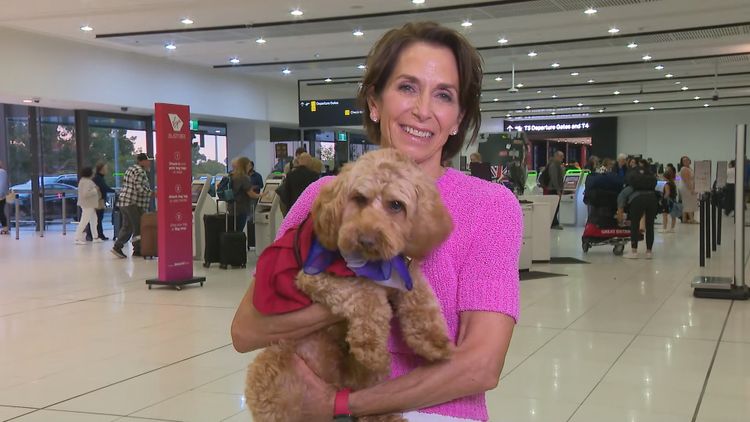
Should cats and dogs be allowed on domestic flights?

- Virgin australia
Send your stories to [email protected]
Property News: Couple strike it rich after finding 400-year-old coins hidden under their kitchen floor.
Top Stories

Judge rejects mercy killing claims in sentence for family violence murder

TODAY IN HISTORY: 'Not guilty' verdict triggers storm of violence

How a struggling Sydney family got the keys to a waterfront mansion

'Disappointed' star seeking exit after Souths decision
Woof Woof! Virgin Australia Explores Bringing Pets Onboard Flights
By kriti gupta / play , sydney , travel / 7 march 2024.
By Kriti Gupta
It’s time to hit the skies with fido.
For pet owners, the annual family vacation often comes with a difficult decision – what to do with the furry member of the family? Virgin Australia is hoping to take the stress out of pet travel with a new initiative – allowing cats and small dogs to fly in the cabin alongside their humans.
While the plan is still awaiting regulatory approval, it has the potential to be a game changer for pet owners in Australia. Currently, most airlines restrict pets to cargo holds an option that can be unsettling for both pets and owners.
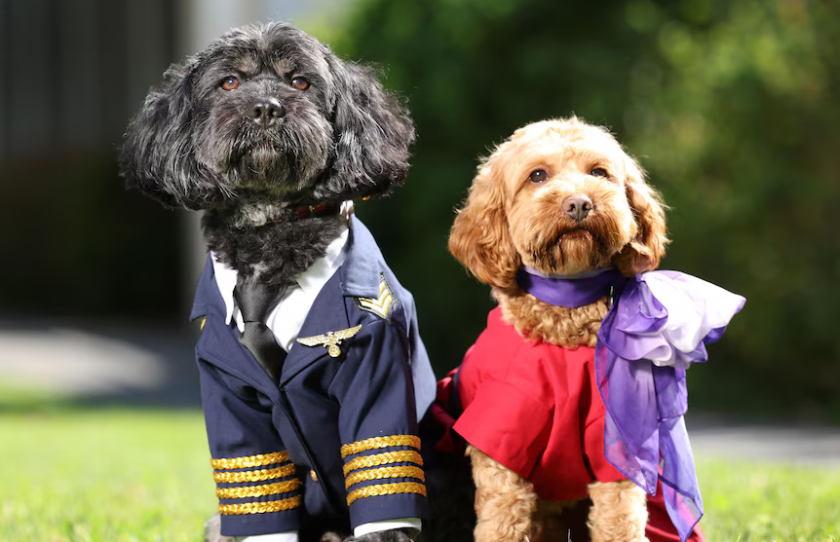
Virgin Australia isn’t proposing a free-for-all fur fest in the cabin. There will be strict guidelines. Only small cats and dogs will be permitted, and they’ll need to travel in a designated carrier that fits comfortably under the seat in front of their owner. Lap snuggles will be off-limits, and specific designated rows will be allocated for pet-carrying passengers. So why the change? Virgin Australia isn’t the first airline to explore in-cabin pet travel – it’s a concept that’s already taken off in North America. Results from Virgin Australia’s research suggest a strong appetite for this option among Australian pet owners. With nearly 70% of households having a furry friend, the ability to travel together could be a welcome change.
There are, of course, some logistical considerations. The airline will need to ensure clear guidelines and proper training for staff to manage the new furry additions onboard. For fellow passengers with allergies or concerns, Virgin Australia will likely need to implement a clear communication strategy to ensure everyone has a comfortable flight.
If all goes according to plan, Virgin Australia could be welcoming pets onboard within the next year. For pet owners dreaming of adventures with their furry companions, this news is a reason to wag their tails!
Related news: Say Goodbye to Carousel Stress With Virgin Australia’s International Baggage Tracking
Sign Me Up!
Get the best of your city, special offers and more
Virgin Australia flying with pets
What is virgin australia policy on pet acceptance.
The airline accepts dogs and cats for pet travel on domestic flights . Pets are transported in the cargo hold of the aircraft, except for authorized Assistance Dogs and Guide Dogs , which are permitted to accompany a person with a disability in the cabin.
How can I make a booking for my pet?
Currently, Virgin Australia requires all customers wishing to book travel with their pet to make a booking with a Commercial Pet Transport Company .
Service Dogs
An Assistance Dog accompanies a person with a disability other than a vision or hearing impairment. For travel on domestic and international short-haul flights, Virgin Australia will only accept Assistance Dogs that have been appropriately trained to assist with a disability. If the Assistance Dog has been trained by a training organization pre-approved by Virgin Australia, all you need to provide is a document that confirms the dog was trained by that organization. If the Assistance Dog has not been trained by a pre-approved organization, Virgin Australia requires further information to determine whether the Assistance Dog can be accepted in the cabin.
Guide/Hearing Dogs are permitted by law to accompany their handler in all places, provided that they have the proper credentials. Guide/Hearing Dogs are permitted in the cabin of all the aircraft when they are traveling with their owner who is entirely dependent on the Guide/Hearing Dog for mobility.
When traveling with an Assistance/Guide Dog, the booking must be made through the Guest Contact Centre (Internet discount fare will be honored). Service Dogs are carried free of charge . The dog must be harnessed, wearing an identifying coat, accompanied by a trainer, and seated on an absorbent mat for the duration of the flight, supplied by the handler. Only two Service Dogs per flight are permitted to travel on domestic and international short-haul flights .
More information here >>
Virgin Australia info
- Covid Rules
- Baggage & carry-on
Virgin Australia seating maps
- Airbus A320
- Airbus A330 200
- Airbus A330 200 Config. 2
- Boeing B737 700
- Boeing B737 800
- Boeing B737 800 Premium Economy
- Boeing B777 300
- Embraer 190
Recent Travel Tips
Top airlines.
- Delta Airlines
- Turkish Airlines
- United Airlines
As featured on
REQUEST A QUOTE
- Our Services
- How Pet Travel Works
- Measuring Pets
- Domestic Travel
- International Pet Travel
- Pet Import From NZ to Australia
- Travel Crates
- Import Quarantine
- What Our Customers Are Saying
- Our Industry Partners
- New Zealand
- United Kingdom
- Virgin Australia
- Air New Zealand
- Japan Airlines
- Singapore Airlines
- China Airlines
- Cathay Pacific
- Domestic FAQ
- International FAQ
- Domestic Quote
- International Quote
- NZ to AUS International Quote

Departure Pets relocates pets domestically with Virgin Airlines.
At Departure Pets , our team are well equipped to take care of everything associated with your pets relocation; From residence collection to boarding, flight bookings and delivery to their new home - We do it all! Virgin Australia has individual restrictions and requirements for pet travel. Read on for a breakdown of what Departure Pets can service with Virgin Australia.
Please note, the below information is relating to Departure Pets individual pet travel services and is not a reflection of what Virgin Australia can or cannot do independently of a pet relocation with Departure Pets .
Virgin Australia Origin Ports
These are the only ports Departure Pets can fly out of with Virgin Australia
- Coolangatta (Gold Coast)
- Port Hedland
- Rockhampton
Virgin Australia Destinations
These are the only ports Departure Pets can fly into with Virgin Australia
- Alice Springs
- Port Headland
Virgin Australia Restricted Breeds
If your pet is classified as any of the below breeds or is considered a Brachycephalic breed, it will be able to fly on Virgin Airlines under a BOAS. This must be completed by an AVA vet within 7 days of your pets departure, and are restricted to certain ports. All non brachy breeds can fly at 8 weeks of age. If the pet is a brachy breed, they must be 12 weeks of age to fly.
THIS DOES NOT INCLUDE BRACHYCEPHALIC CROSS BREEDS - VIRGIN AUSTRALIA DOES NOT FLY BRACHY CROSS BREEDS. DEPARTURE PETS DOES NOT FLY BRACHYCEPHALIC BREEDS AND THEIR CROSS BREEDS ON VIRGIN AUSTRALIA.
BRACHYCEPHALIC BREEDS
- Affenpinscher
- American Bully
- American Bulldog
- Australian Bulldog
- Boston Terrier
- Brussels Griffon/ Griffon Bruxellois
- British/ English Bulldog
- Dogue De Bordeaux
- English Toy Spaniel/ King Charles Spaniel
- French Mastiff
- French Bulldog
- Japanese Chin/ Japanese Spaniel
- Neopolitan Mastiff
- Pug (Chinese Pug, Dutch Pug, Japanese Pug)
- Shih-Zhu (Tsu) (Tzu)
- Tibetan Spaniel
- Valley Bulldog
- Exotic Shorthair Cat
- Himalayan Cat
- Persian Cat
NON BRACHYCEPHALIC BREEDS
- Fila Brasilerio
- Japanese Tosa
- Dogo Argentino
- American Pit Bull and other Pit Bull Breeds
- Perro de Presa Canario (Presa Canario)
- Czechoslovakian wolfdog or Czechoslovakian Vlcak
- Saarloos wolfdog or Saarloos wolfhound
- Lupo Italiano or Italian wolfdog
- Kunming wolfdog or Kunming dog
Virgin Documents
If your pet is booked to fly with Virgin, there will be documentation required to be completed prior to your pets travel:
- Fit to Fly Certificate (for pets under 12 weeks and over 12 years of age)
Request A Quote
Step 1 of 4.
- Name * First Last
- Email * Enter Email Confirm Email
- Phone Number *
- Number of Pets * Please enter a number from 1 to 6 .
- Airport of Departure * Adelaide (ADL) Brisbane (BNE) Canberra (CBR) Darwin (DRW) Hobart (HBA) Melbourne (MEL) Perth (PER) Sydney (SYD) Albury (ABX) Alice Springs (ASP) Ballina (BNK) Bathurst (BHS) Broome (BME) Bundaberg (BDB) Cairns (CNS) Coffs Harbour (CFS) Coolangatta (OOL) Devonport (DPO) Dubbo (DBO) Harvey Bay (HVB) Kalgoorlie (KGI) Karratha (KTA) Kununarra (KNX) Launceston (LST) Mackay (MKY) Mildura (MQL) Mount Gambier (MGB) Newcastle (NTL) Newman (ZNE) Onslow (ONS) Orange (OAG) Port Hedland (PHE) Rockhampton (ROK) Tamworth (TMW) Toowoomba (WTB) Townsville (TSV) Wagga Wagga (WGA)
- Destination Airport * Abu Dhabi ABU Almaty ALA Amsterdam AMS Athens ATH Atlanta ATL Auckland AKL Bangalore BLR Bangkok BKK Barcelona BCN Beirut BEY Belgrade BEG Bengaluru BLR Berlin BER Boston BOS Bogota BOG Brussels BRU Budapest BUD Buenos Aires EZE Cairo CAI Calgary YYC Capetown CPT Carrasco/Montevideo MVD Chennai MAA Cebu CEB Chicago ORD Christchurch CHC Copenhagen CPH Dallas Fort Worth DFW Delhi DEL Denver DEN Dhaka DAC Detroit DTT Doha DOH Dubai DXB Dublin DUB Dunedin DUD Dusseldorf DUS Edinburgh EDI Edmonton YEG Florence FLR Frankfurt FRA Geneva GVA Glasgow GLA Gatwick LGW Gothenburg GOT Gisborne GIS Halifax YHZ Harare HRE Hamburg HAM Helsinki HEL Hong Kong HKG Honolulu HNL Houston IAH Hyderabad HYD Invercargill IVC Istanbul IST Johannesburg JNB Karachi KHI Kolkata CCU Kyiv IEV Larnaca LCA Lahore LHE Lisbon LIS London LHR Los Angeles LAX Madrid MAD Manchester MAN Mexico MEX Miami MIA Milan MXP Malta MLA Manila MNL Montreal YUL Moscow DME Mumbai BOM Munich MUC Nairobi NBO Napier/Hastings NPE Narita - Tokyo NRT Nelson NSN New Plymouth NPL New York JFK Nice NCE Nuku'alofa TBU Orlando MCO Oslo OSL Palmerston North PMR Paris CDG Philadelphia PHL Prague PRG Queenstown ZQN Rarotonga RAR Reykjavik REK Riyadh RUH Rome FCO Salt Lake City SLC San Francisco SFO Santiago SCL Sao Paulo GRU Seattle SEA Singapore SIN Sofia SOF St Petersburg LED Stockholm ARN Tahiti PPT Taipei TPE Tehran IKA Toronto YYZ Vancouver YVR Venice VCE Vienna VIE Warsaw WAW Wellington WLG Whangarei WRE Washington IAD Yerevan Zagreb ZAG Zurich ZRH Other
- Destination Airport (Other)
- Estimated Pet Arrival Date to Destination Airport * DD slash MM slash YYYY
- Type of Animal * Dog Cat
- Breed of Animal * Affenpinscher Afghan Hound African Boerboel Airedale Terrier Akita Alaskan Klee Kai Alaskan Malamute American Bulldog American Eskimo Dog ( Miniature) American Eskimo Dog (Standard) American Eskimo Dog (Toy) American Staffordshire Terrier Anatolian Shepherd Dog Australian Bandog (Mastiff) Australian Bulldog Australian Cattle Dog (Blue Heeler) Australian Cobberdog (Labradoodle) Australian Dingo Australian Kelpie Australian Koolie Australian Shepherd Australian Silky Terrier Australian Stumpy Tail Cattle Dog Australian Terrier Azawakh Hound Basenji Basset Fauve De Bretagne Basset Hound Beagle Beaglier (Beagle x Cavalier King Charles Spaniel) Bearded Collie Beauceron Bedlington Terrier Belgian Malinois Belgian Shepherd Dog Bergamasco Sheepdog Bernese Mountain Dog Bichon Frise Black Mouth Cur Black Russian Terrier Bloodhound Bluetick Coonhound Bolognese Border Collie Border Terrier Borzoi Boston Terrier Bouvier Des Flandres Boxer Bracco Italiano Dog Briard British Bulldog Brittany Bull Arab Bull Terrier Bull Terrier (Miniature) Bullmastiff Cairn Terrier Canaan Dog Cane Corso Italiano (Italian Mastiff) Carolina Dog Catahoula Cattle Dog Caucasian Shepherd Cavalier King Charles Spaniel Cavoodle (C.K.C.S x Poodle) Central Asian Shepherd Dog (Ovtcharka) Cesky Terriers Chesapeake Bay Retriever Chihuahua (Apple Head) Chihuahua (Deer Head) Chinese Crested Dog Chow Chow Clumber Spaniel Cocker Spaniel (American) Cocker Spaniel (English) Collie (Rough) Collie (Smooth) Coton De Tulear Croation Sheepdog (Shepherd) Curly Coated Retriever Czechoslovakian Wolfdog Dachshund Dachshund (Long Haired) Dachshund (Miniature) Dalmation Dandie Dinmont Terrier Deerhound Dingo Doberman Dogue De Bordeaux (French Mastiff) Dutch Shepherd English Mastiff English Pointer English Setter English Springer Spaniel English Staffordshire Terrier English Toy Spaniel English Toy Terrier Entlebucher Mountain Dog Eurasier Eurohound Field Spaniel Finnish Lapphund Finnish Spitz Flat Coated Retriever Fox Terrier Foxhound French Bulldog German Pinscher German Shepherd Dog German Shorthaired Pointer German Spitz Medium (Mittel) German Spitz Small (Klein) German Wirehaired Pointer Glen Of Imaal Terrier Golden Retriever Gordon Setter Great Dane Greek Sheepdog (Shepherd) Greyhound Griffon Bruxellois (Brussels Griffon) Groodle (Golden Retriever X Poodle) Hamiltonstovare Harrier Havanese Hovawart Hungarian Puli Hungarian Vizsla Ibizan Hound Irish Red & White Setter Irish Setter Irish Terrier Irish Water Spaniel Irish Wolfhound Italian Greyhound Italian Spinone Jack Russell Terrier Jagdterrier (German Hunt Terrier) Japanese Chin Japanese Spitz Johnson American Bulldog Kangal Dog Keeshond Kelpie Kerry Blue Terrier King Charles Spaniel Komondor Kuvasz Labradoodle (Labrador Retriever X Poodle) Labrador Retriever Lagotto Romagnolo Lakeland Terrier Large Munsterlander Leonberger Lhasa Apso Lowchen Lurcher Maltese Maltese / Shih Tzu X Manchester Terrier Maremma Sheepdog Mini Fox Terrier Miniature Pinscher Moodle (Maltese x Poodel) Mountain Cur Neopolitan Mastiff New Zealand Huntaway Newfoundland Norfolk Terrier Norwegian Buhund Norwegian Elkhound Norwich Terrier Nova Scotia Duck Tolling Retriever Old English Sheepdog Old English Bulldogge Otterhound Papillon Parson Jack Russell Terrier Patterdale Terrier Pekingese Peruvian Hairless Dog Petit Basset Griffon Vendeen Pharaoh Hound Podenco Csnario Pointer Polish Lowland Sheepdog Pomeranian Poodle (Miniature) Poodle (Standard) Poodel (Toy) Portuguese Podengo Grande Portuguese Podengo Medio Portuguese Podengo Pequeno (Small) Portuguese Water Dog Prague Ratter Pug Pugalier (Pug X Cavalier King Charles Spaniel) Puli Pumi Pyrenean Mountain Dog Rat Terrier Red Heeler Rhodesian Ridgeback Rottweiler Russian Toy Terrier Saluki Samoyed Sarplaninac Dog Schipperke Schnauzer (Giant) Schnauzer (Miniature) Schnauzer (Standard) Scottish Terrier Sealyham Terrier Shar Pei Shetland Sheepdog Shiba Inu Shih Tzu Siberian Husky Silky Terrier Skye Terrier Sloughi Small (Kleiner) Munsterlander Smithfield Soft Coated Wheaten Terrier Spanish Galgo (Galgo Espanol) Spoodle (English Cocker Spaniel x Poodle) Springer Spaniel St. Bernard Staghound Stumpy Tail Cattle dog Sussex Spaniel Swedish Vallhund Swiss Bernese Swiss Shepherd Taiwanese Dog (Formosan Mountain Dog) Tenterfield Terrier Tibetan Mastiff Tibetan Spaniel Tibetan Terrier Weimaraner Welsh Corgi (Cardigan) Welsh Corgi (Pembroke) Welsh Springer Spaniel Welsh Terrier West Highland white Terrier Whippet Wirehaired Pointing Griffon Xoloitzcuintli Yorshire Terrier Dog
- Breed of Animal * Abyssinian American Curl American Shorthair Arabian Mau Australian Mist Australian Tiffanie Balinese Bengal Birman Bombay British Shorthair Burmese (European) Burmilla Chantilly- Tiffany Chinchilla Cornish Rex Devon Rex Domestic Long Hair Domestic Medium Hair Domestic Short Hair Egyptian Mau European Short Hair Exotic Himalayan Japanese Bobtail Korat Lykoi Maine Coon Mandalay Manx Munchkin Cat Norwegian Forest Cat Ocicat Orientals Persian Ragamuffin Ragdoll Russian Black Russian Blue Russian White Scottish Fold Scottish Short Hair Selkirk Rex Siamese Siberian Singapura SnowShoe Somali Sphynx Tonkinese Turkish Van Toyger Cat
- Age of Animal * 8 Weeks 9 Weeks to under 12 Weeks 12 Weeks to 5 Months 6 Months to 8 Months 9 Months to under 12 Years 12 Years and over
- Travel Crate Requirments * Purchase Own
- Length (cms)
- Width (cms)
- Height (cms)
- ADD ANOTHER PET
- Second Pet's Name
- Type of Animal 2 * Dog Cat
- Breed of Animal 2 * Affenpinscher Afghan Hound African Boerboel Airedale Terrier Akita Alaskan Klee Kai Alaskan Malamute American Bulldog American Eskimo Dog ( Miniature) American Eskimo Dog (Standard) American Eskimo Dog (Toy) American Staffordshire Terrier Anatolian Shepherd Dog Australian Bandog (Mastiff) Australian Bulldog Australian Cattle Dog (Blue Heeler) Australian Cobberdog (Labradoodle) Australian Dingo Australian Kelpie Australian Koolie Australian Shepherd Australian Silky Terrier Australian Stumpy Tail Cattle Dog Australian Terrier Azawakh Hound Basenji Basset Fauve De Bretagne Basset Hound Beagle Beaglier (Beagle x Cavalier King Charles Spaniel) Bearded Collie Beauceron Bedlington Terrier Belgian Malinois Belgian Shepherd Dog Bergamasco Sheepdog Bernese Mountain Dog Bichon Frise Black Mouth Cur Black Russian Terrier Bloodhound Bluetick Coonhound Bolognese Border Collie Border Terrier Borzoi Boston Terrier Bouvier Des Flandres Boxer Bracco Italiano Dog Briard British Bulldog Brittany Bull Arab Bull Terrier Bull Terrier (Miniature) Bullmastiff Cairn Terrier Canaan Dog Cane Corso Italiano (Italian Mastiff) Carolina Dog Catahoula Cattle Dog Caucasian Shepherd Cavalier King Charles Spaniel Cavoodle (C.K.C.S x Poodle) Central Asian Shepherd Dog (Ovtcharka) Cesky Terriers Chesapeake Bay Retriever Chihuahua (Apple Head) Chihuahua (Deer Head) Chinese Crested Dog Chow Chow Clumber Spaniel Cocker Spaniel (American) Cocker Spaniel (English) Collie (Rough) Collie (Smooth) Coton De Tulear Croation Sheepdog (Shepherd) Curly Coated Retriever Czechoslovakian Wolfdog Dachshund Dachshund (Long Haired) Dachshund (Miniature) Dalmation Dandie Dinmont Terrier Deerhound Dingo Doberman Dogue De Bordeaux (French Mastiff) Dutch Shepherd English Mastiff English Pointer English Setter English Springer Spaniel English Staffordshire Terrier English Toy Spaniel English Toy Terrier Entlebucher Mountain Dog Eurasier Eurohound Field Spaniel Finnish Lapphund Finnish Spitz Flat Coated Retriever Fox Terrier Foxhound French Bulldog German Pinscher German Shepherd Dog German Shorthaired Pointer German Spitz Medium (Mittel) German Spitz Small (Klein) German Wirehaired Pointer Glen Of Imaal Terrier Golden Retriever Gordon Setter Great Dane Greek Sheepdog (Shepherd) Greyhound Griffon Bruxellois (Brussels Griffon) Groodle (Golden Retriever X Poodle) Hamiltonstovare Harrier Havanese Hovawart Hungarian Puli Hungarian Vizsla Ibizan Hound Irish Red & White Setter Irish Setter Irish Terrier Irish Water Spaniel Irish Wolfhound Italian Greyhound Italian Spinone Jack Russell Terrier Jagdterrier (German Hunt Terrier) Japanese Chin Japanese Spitz Johnson American Bulldog Kangal Dog Keeshond Kelpie Kerry Blue Terrier King Charles Spaniel Komondor Kuvasz Labradoodle (Labrador Retriever X Poodle) Labrador Retriever Lagotto Romagnolo Lakeland Terrier Large Munsterlander Leonberger Lhasa Apso Lowchen Lurcher Maltese Maltese / Shih Tzu X Manchester Terrier Maremma Sheepdog Mini Fox Terrier Miniature Pinscher Moodle (Maltese x Poodel) Mountain Cur Neopolitan Mastiff New Zealand Huntaway Newfoundland Norfolk Terrier Norwegian Buhund Norwegian Elkhound Norwich Terrier Nova Scotia Duck Tolling Retriever Old English Sheepdog Old English Bulldogge Otterhound Papillon Parson Jack Russell Terrier Patterdale Terrier Pekingese Peruvian Hairless Dog Petit Basset Griffon Vendeen Pharaoh Hound Podenco Csnario Pointer Polish Lowland Sheepdog Pomeranian Poodle (Miniature) Poodle (Standard) Poodel (Toy) Portuguese Podengo Grande Portuguese Podengo Medio Portuguese Podengo Pequeno (Small) Portuguese Water Dog Prague Ratter Pug Pugalier (Pug X Cavalier King Charles Spaniel) Puli Pumi Pyrenean Mountain Dog Rat Terrier Red Heeler Rhodesian Ridgeback Rottweiler Russian Toy Terrier Saluki Samoyed Sarplaninac Dog Schipperke Schnauzer (Giant) Schnauzer (Miniature) Schnauzer (Standard) Scottish Terrier Sealyham Terrier Shar Pei Shetland Sheepdog Shiba Inu Shih Tzu Siberian Husky Silky Terrier Skye Terrier Sloughi Small (Kleiner) Munsterlander Smithfield Soft Coated Wheaten Terrier Spanish Galgo (Galgo Espanol) Spoodle (English Cocker Spaniel x Poodle) Springer Spaniel St. Bernard Staghound Stumpy Tail Cattle dog Sussex Spaniel Swedish Vallhund Swiss Bernese Swiss Shepherd Taiwanese Dog (Formosan Mountain Dog) Tenterfield Terrier Tibetan Mastiff Tibetan Spaniel Tibetan Terrier Weimaraner Welsh Corgi (Cardigan) Welsh Corgi (Pembroke) Welsh Springer Spaniel Welsh Terrier West Highland white Terrier Whippet Wirehaired Pointing Griffon Xoloitzcuintli Yorshire Terrier Dog
- Breed of Animal 2 * Abyssinian American Curl American Shorthair Arabian Mau Australian Mist Australian Tiffanie Balinese Bengal Birman Bombay British Shorthair Burmese (European) Burmilla Chantilly- Tiffany Chinchilla Cornish Rex Devon Rex Domestic Long Hair Domestic Medium Hair Domestic Short Hair Egyptian Mau European Short Hair Exotic Himalayan Japanese Bobtail Korat Lykoi Maine Coon Mandalay Manx Munchkin Cat Norwegian Forest Cat Ocicat Orientals Persian Ragamuffin Ragdoll Russian Black Russian Blue Russian White Scottish Fold Scottish Short Hair Selkirk Rex Siamese Siberian Singapura SnowShoe Somali Sphynx Turkish Angora Turkish Van Tonkinese Toyger Cat
- Age of Animal 2 * 8 Weeks 9 Weeks to under 12 Weeks 12 Weeks to 5 Months 6 Months to 8 Months 9 Months to under 12 Years
- Travel Crate Requirements Animal 2 * Purchase Own
- Third Pet's Name
- Type of Animal 3 * Dog Cat
- Age of Animal 3 * 8 Weeks 9 Weeks to under 12 Weeks 12 Weeks to 5 Months 6 Months to 8 Months 9 Months to under 12 Years 12 Years and over
- Breed of Animal 3 * Affenpinscher Afghan Hound African Boerboel Airedale Terrier Akita Alaskan Klee Kai Alaskan Malamute American Bulldog American Eskimo Dog ( Miniature) American Eskimo Dog (Standard) American Eskimo Dog (Toy) American Staffordshire Terrier Anatolian Shepherd Dog Australian Bandog (Mastiff) Australian Bulldog Australian Cattle Dog (Blue Heeler) Australian Cobberdog (Labradoodle) Australian Dingo Australian Kelpie Australian Koolie Australian Shepherd Australian Silky Terrier Australian Stumpy Tail Cattle Dog Australian Terrier Azawakh Hound Basenji Basset Fauve De Bretagne Basset Hound Beagle Beaglier (Beagle x Cavalier King Charles Spaniel) Bearded Collie Beauceron Bedlington Terrier Belgian Malinois Belgian Shepherd Dog Bergamasco Sheepdog Bernese Mountain Dog Bichon Frise Black Mouth Cur Black Russian Terrier Bloodhound Bluetick Coonhound Bolognese Border Collie Border Terrier Borzoi Boston Terrier Bouvier Des Flandres Boxer Bracco Italiano Dog Briard British Bulldog Brittany Bull Arab Bull Terrier Bull Terrier (Miniature) Bullmastiff Cairn Terrier Canaan Dog Cane Corso Italiano (Italian Mastiff) Carolina Dog Catahoula Cattle Dog Caucasian Shepherd Cavalier King Charles Spaniel Cavoodle (C.K.C.S x Poodle) Central Asian Shepherd Dog (Ovtcharka) Cesky Terriers Chesapeake Bay Retriever Chihuahua (Apple Head) Chihuahua (Deer Head) Chinese Crested Dog Chow Chow Clumber Spaniel Cocker Spaniel (American) Cocker Spaniel (English) Collie (Rough) Collie (Smooth) Coton De Tulear Croation Sheepdog (Shepherd) Curly Coated Retriever Czechoslovakian Wolfdog Dachshund Dachshund (Long Haired) Dachshund (Miniature) Dalmation Dandie Dinmont Terrier Deerhound Dingo Doberman Dogue De Bordeaux (French Mastiff) Dutch Shepherd English Mastiff English Pointer English Setter English Springer Spaniel English Staffordshire Terrier English Toy Spaniel English Toy Terrier Entlebucher Mountain Dog Eurasier Eurohound Field Spaniel Finnish Lapphund Finnish Spitz Flat Coated Retriever Fox Terrier Foxhound French Bulldog German Pinscher German Shepherd Dog German Shorthaired Pointer German Spitz Medium (Mittel) German Spitz Small (Klein) German Wirehaired Pointer Glen Of Imaal Terrier Golden Retriever Gordon Setter Great Dane Greek Sheepdog (Shepherd) Greyhound Griffon Bruxellois (Brussels Griffon) Groodle (Golden Retriever X Poodle) Hamiltonstovare Harrier Havanese Hovawart Hungarian Puli Hungarian Vizsla Ibizan Hound Irish Red & White Setter Irish Setter Irish Terrier Irish Water Spaniel Irish Wolfhound Italian Greyhound Italian Spinone Jack Russell Terrier Jagdterrier (German Hunt Terrier) Japanese Chin Japanese Spitz Johnson American Bulldog Kangal Dog Keeshond Kelpie Kerry Blue Terrier King Charles Spaniel Komondor Kuvasz Labradoodle (Labrador Retriever X Poodle) Labrador Retriever Lagotto Romagnolo Lakeland Terrier Large Munsterlander Leonberger Lhasa Apso Lowchen Lurcher Maltese Maltese / Shih Tzu X Manchester Terrier Maremma Sheepdog Mini Fox Terrier Miniature Pinscher Moodle (Maltese x Poodel) Mountain Cur Neopolitan Mastiff New Zealand Huntaway Newfoundland Norfolk Terrier Norwegian Buhund Norwegian Elkhound Norwich Terrier Nova Scotia Duck Tolling Retriever Old English Sheepdog Old English Bulldogge Otterhound Papillon Parson Jack Russell Terrier Patterdale Terrier Pekingese Peruvian Hairless Dog Petit Basset Griffon Vendeen Pharaoh Hound Podenco Csnario Pointer Polish Lowland Sheepdog Pomeranian Poodle (Miniature) Poodle (Standard) Poodel (Toy) Portuguese Podengo Grande Portuguese Podengo Medio Portuguese Podengo Pequeno (Small) Portuguese Water Dog Prague Ratter Pug Pugalier (Pug X Cavalier King Charles Spaniel) Puli Pumi Pyrenean Mountain Dog Rat Terrier Red Heeler Rhodesian Ridgeback Rottweiler Russian Toy Terrier Saluki Samoyed Sarplaninac Dog Schipperke Schnauzer (Giant) Schnauzer (Miniature) Schnauzer (Standard) Scottish Terrier Sealyham Terrier Shar Pei Shetland Sheepdog Shiba Inu Shih Tzu Siberian Husky Silky Terrier Skye Terrier Sloughi Small (Kleiner) Munsterlander Smithfield Soft Coated Wheaten Terrier Spanish Galgo (Galgo Espanol) Spoodle (English Cocker Spaniel x Poodle) Springer Spaniel St. Bernard Staghound Stumpy Tail Cattle dog Sussex Spaniel Swedish Vallhund Swiss Bernese Swiss Shepherd Taiwanese Dog (Formosan Mountain Dog) Tenterfield Terrier Tibetan Mastiff Tibetan Spaniel Tibetan Terrier Weimaraner Welsh Corgi (Cardigan) Welsh Corgi (Pembroke) Welsh Springer Spaniel Welsh Terrier West Highland white Terrier Whippet Wirehaired Pointing Griffon Xoloitzcuintli Yorshire Terrier Dog
- Breed of Animal 3 * Abyssinian American Curl American Shorthair Arabian Mau Australian Mist Australian Tiffanie Balinese Bengal Birman Bombay British Shorthair Burmese (European) Burmilla Chantilly- Tiffany Chinchilla Cornish Rex Devon Rex Domestic Long Hair Domestic Medium Hair Domestic Short Hair Egyptian Mau European Short Hair Exotic Himalayan Japanese Bobtail Korat Lykoi Maine Coon Mandalay Manx Munchkin Cat Norwegian Forest Cat Ocicat Orientals Persian Ragamuffin Ragdoll Russian Black Russian Blue Russian White Scottish Fold Scottish Short Hair Selkirk Rex Siamese Siberian Singapura SnowShoe Somali Sphynx Tokinese Turkish Angora Tonkinese Turkish Van Toyger Cat
- Travel Crate Requirements Animal 3 * Purchase Own
- Fourth Pet's Name
- Type of Animal 4 * Dog Cat
- Age of Animal 4 * 8 Weeks 9 Weeks to under 12 Weeks 12 Weeks to 5 Months 6 Months to 8 Months 9 Months to under 12 Years 12 Years and over
- Breed of Animal 4 * Affenpinscher Afghan Hound African Boerboel Airedale Terrier Akita Alaskan Klee Kai Alaskan Malamute American Bulldog American Eskimo Dog ( Miniature) American Eskimo Dog (Standard) American Eskimo Dog (Toy) American Staffordshire Terrier Anatolian Shepherd Dog Australian Bandog (Mastiff) Australian Bulldog Australian Cattle Dog (Blue Heeler) Australian Cobberdog (Labradoodle) Australian Dingo Australian Kelpie Australian Koolie Australian Shepherd Australian Silky Terrier Australian Stumpy Tail Cattle Dog Australian Terrier Azawakh Hound Basenji Basset Fauve De Bretagne Basset Hound Beagle Beaglier (Beagle x Cavalier King Charles Spaniel) Bearded Collie Beauceron Bedlington Terrier Belgian Malinois Belgian Shepherd Dog Bergamasco Sheepdog Bernese Mountain Dog Bichon Frise Black Mouth Cur Black Russian Terrier Bloodhound Bluetick Coonhound Bolognese Border Collie Border Terrier Borzoi Boston Terrier Bouvier Des Flandres Boxer Bracco Italiano Dog Briard British Bulldog Brittany Bull Arab Bull Terrier Bull Terrier (Miniature) Bullmastiff Cairn Terrier Canaan Dog Cane Corso Italiano (Italian Mastiff) Carolina Dog Catahoula Cattle Dog Caucasian Shepherd Cavalier King Charles Spaniel Cavoodle (C.K.C.S x Poodle) Central Asian Shepherd Dog (Ovtcharka) Cesky Terriers Chesapeake Bay Retriever Chihuahua (Apple Head) Chihuahua (Deer Head) Chinese Crested Dog Chow Chow Clumber Spaniel Cocker Spaniel (American) Cocker Spaniel (English) Collie (Rough) Collie (Smooth) Coton De Tulear Croation Sheepdog (Shepherd) Curly Coated Retriever Czechoslovakian Wolfdog Dachshund Dachshund (Long Haired) Dachshund (Miniature) Dalmation Dandie Dinmont Terrier Deerhound Dingo Doberman Dogue De Bordeaux (French Mastiff) Dogue De Bordeaux (French Mastiff) Dutch Shepherd English Mastiff English Pointer English Setter English Setter English Springer Spaniel English Staffordshire Terrier English Toy Spaniel English Toy Terrier Entlebucher Mountain Dog Eurasier Eurohound Field Spaniel Finnish Lapphund Finnish Spitz Flat Coated Retriever Fox Terrier Foxhound French Bulldog German Pinscher German Shepherd Dog German Shorthaired Pointer German Spitz Medium (Mittel) German Spitz Small (Klein) German Wirehaired Pointer Glen Of Imaal Terrier Golden Retriever Gordon Setter Great Dane Greek Sheepdog (Shepherd) Greyhound Griffon Bruxellois (Brussels Griffon) Groodle (Golden Retriever X Poodle) Hamiltonstovare Harrier Havanese Hovawart Hungarian Puli Hungarian Vizsla Ibizan Hound Irish Red & White Setter Irish Setter Irish Terrier Irish Water Spaniel Irish Wolfhound Italian Greyhound Italian Spinone Jack Russell Terrier Jagdterrier (German Hunt Terrier) Japanese Chin Japanese Spitz Johnson American Bulldog Kangal Dog Keeshond Kelpie Kerry Blue Terrier King Charles Spaniel Komondor Kuvasz Labradoodle (Labrador Retriever X Poodle) Labrador Retriever Lagotto Romagnolo Lakeland Terrier Large Munsterlander Leonberger Lhasa Apso Lowchen Lurcher Maltese Maltese / Shih Tzu X Manchester Terrier Maremma Sheepdog Mini Fox Terrier Miniature Pinscher Moodle (Maltese x Poodel) Mountain Cur Neopolitan Mastiff New Zealand Huntaway Newfoundland Norfolk Terrier Norwegian Buhund Norwegian Elkhound Norwich Terrier Nova Scotia Duck Tolling Retriever Old English Sheepdog Old English Bulldogge Otterhound Papillon Parson Jack Russell Terrier Patterdale Terrier Pekingese Peruvian Hairless Dog Petit Basset Griffon Vendeen Pharaoh Hound Podenco Csnario Pointer Polish Lowland Sheepdog Pomeranian Poodle (Miniature) Poodle (Standard) Poodel (Toy) Portuguese Podengo Grande Portuguese Podengo Medio Portuguese Podengo Pequeno (Small) Portuguese Water Dog Prague Ratter Pug Pugalier (Pug X Cavalier King Charles Spaniel) Puli Pumi Pyrenean Mountain Dog Rat Terrier Red Heeler Rhodesian Ridgeback Rottweiler Russian Toy Terrier Saluki Samoyed Sarplaninac Dog Schipperke Schnauzer (Giant) Schnauzer (Miniature) Schnauzer (Standard) Scottish Terrier Sealyham Terrier Shar Pei Shetland Sheepdog Shiba Inu Shih Tzu Siberian Husky Silky Terrier Skye Terrier Sloughi Small (Kleiner) Munsterlander Smithfield Soft Coated Wheaten Terrier Spanish Galgo (Galgo Espanol) Spoodle (English Cocker Spaniel x Poodle) Springer Spaniel St. Bernard Staghound Stumpy Tail Cattle dog Sussex Spaniel Swedish Vallhund Swiss Bernese Swiss Shepherd Taiwanese Dog (Formosan Mountain Dog) Tenterfield Terrier Tibetan Mastiff Tibetan Spaniel Tibetan Terrier Weimaraner Welsh Corgi (Cardigan) Welsh Corgi (Pembroke) Welsh Springer Spaniel Welsh Terrier West Highland white Terrier Whippet Wirehaired Pointing Griffon Xoloitzcuintli Yorshire Terrier Dog
- Breed of Animal 4 * Abyssinian American Curl American Shorthair Arabian Mau Australian Mist Australian Tiffanie Balinese Bengal Birman Bombay British Shorthair Burmese (European) Burmilla Chantilly- Tiffany Chinchilla Cornish Rex Devon Rex Domestic Long Hair Domestic Medium Hair Domestic Short Hair Egyptian Mau European Short Hair Exotic Himalayan Japanese Bobtail Korat Lykoi Maine Coon Mandalay Manx Munchkin Cat Norwegian Forest Cat Ocicat Orientals Persian Ragamuffin Ragdoll Russian Black Russian Blue Russian White Scottish Fold Scottish Short Hair Selkirk Rex Siamese Siberian Singapura SnowShoe Somali Sphynx Tonkinese Turkish Angora Turkish Van Toyger Cat
- Travel Crate Requirments Animal 4 * Purchase Own
- Fifth Pet's Name
- Type of Animal 5 * Dog Cat
- Age of Animal 5 * 8 Weeks 9 Weeks to under 12 Weeks 12 Weeks to 5 Months 6 Months to 8 Months 9 Months to under 12 Years 12 Years and over
- Breed of Animal 5 * Affenpinscher Afghan Hound African Boerboel Airedale Terrier Akita Alaskan Klee Kai Alaskan Malamute American Bulldog American Eskimo Dog ( Miniature) American Eskimo Dog (Standard) American Eskimo Dog (Toy) American Staffordshire Terrier Anatolian Shepherd Dog Australian Bandog (Mastiff) Australian Bulldog Australian Cattle Dog (Blue Heeler) Australian Cobberdog (Labradoodle) Australian Dingo Australian Kelpie Australian Koolie Australian Shepherd Australian Silky Terrier Australian Stumpy Tail Cattle Dog Australian Terrier Azawakh Hound Basenji Basset Fauve De Bretagne Basset Hound Beagle Beaglier (Beagle x Cavalier King Charles Spaniel) Bearded Collie Beauceron Bedlington Terrier Belgian Malinois Belgian Shepherd Dog Bergamasco Sheepdog Bernese Mountain Dog Bichon Frise Black Mouth Cur Black Russian Terrier Bloodhound Bluetick Coonhound Bolognese Border Collie Border Terrier Borzoi Boston Terrier Bouvier Des Flandres Boxer Bracco Italiano Dog Briard British Bulldog Brittany Bull Arab Bull Terrier Bull Terrier (Miniature) Bullmastiff Cairn Terrier Canaan Dog Cane Corso Italiano (Italian Mastiff) Carolina Dog Catahoula Cattle Dog Caucasian Shepherd Cavalier King Charles Spaniel Cavoodle (C.K.C.S x Poodle) Central Asian Shepherd Dog (Ovtcharka) Cesky Terriers Chesapeake Bay Retriever Chihuahua (Apple Head) Chihuahua (Deer Head) Chinese Crested Dog Chow Chow Clumber Spaniel Cocker Spaniel (American) Cocker Spaniel (English) Collie (Rough) Collie (Smooth) Coton De Tulear Croation Sheepdog (Shepherd) Curly Coated Retriever Czechoslovakian Wolfdog Dachshund Dachshund (Long Haired) Dachshund (Miniature) Dalmation Dandie Dinmont Terrier Deerhound Dingo Doberman Dogue De Bordeaux (French Mastiff) Dutch Shepherd English Mastiff English Pointer English Setter English Springer Spaniel English Staffordshire Terrier English Toy Spaniel English Toy Terrier Entlebucher Mountain Dog Eurasier Eurohound Field Spaniel Finnish Lapphund Finnish Spitz Flat Coated Retriever Fox Terrier Foxhound French Bulldog German Pinscher German Shepherd Dog German Shorthaired Pointer German Spitz Medium (Mittel) German Spitz Small (Klein) German Wirehaired Pointer Glen Of Imaal Terrier Golden Retriever Gordon Setter Great Dane Greek Sheepdog (Shepherd) Greyhound Griffon Bruxellois (Brussels Griffon) Groodle (Golden Retriever X Poodle) Hamiltonstovare Harrier Havanese Hovawart Hungarian Puli Hungarian Vizsla Ibizan Hound Irish Red & White Setter Irish Setter Irish Terrier Irish Water Spaniel Irish Wolfhound Italian Greyhound Italian Spinone Jack Russell Terrier Jagdterrier (German Hunt Terrier) Japanese Chin Japanese Spitz Johnson American Bulldog Kangal Dog Keeshond Kelpie Kerry Blue Terrier King Charles Spaniel Komondor Kuvasz Labradoodle (Labrador Retriever X Poodle) Labrador Retriever Lagotto Romagnolo Lakeland Terrier Large Munsterlander Leonberger Lhasa Apso Lowchen Lurcher Maltese Maltese / Shih Tzu X Manchester Terrier Maremma Sheepdog Mini Fox Terrier Miniature Pinscher Moodle (Maltese x Poodel) Mountain Cur Neopolitan Mastiff New Zealand Huntaway Newfoundland Norfolk Terrier Norwegian Buhund Norwegian Elkhound Norwich Terrier Nova Scotia Duck Tolling Retriever Old English Sheepdog Old English Bulldogge Otterhound Papillon Parson Jack Russell Terrier Patterdale Terrier Pekingese Peruvian Hairless Dog Petit Basset Griffon Vendeen Pharaoh Hound Podenco Csnario Pointer Polish Lowland Sheepdog Pomeranian Poodle (Miniature) Poodle (Standard) Poodel (Toy) Portuguese Podengo Grande Portuguese Podengo Medio Portuguese Podengo Pequeno (Small) Portuguese Water Dog Prague Ratter Pug Pugalier (Pug X Cavalier King Charles Spaniel) Puli Pumi Pyrenean Mountain Dog Rat Terrier Red Heeler Rhodesian Ridgeback Rottweiler Russian Toy Terrier Saluki Samoyed Sarplaninac Dog Schipperke Schnauzer (Giant) Schnauzer (Miniature) Schnauzer (Standard) Scottish Terrier Sealyham Terrier Shar Pei Shetland Sheepdog Shiba Inu Shih Tzu Siberian Husky Silky Terrier Skye Terrier Sloughi Small (Kleiner) Munsterlander Smithfield Soft Coated Wheaten Terrier Spanish Galgo (Galgo Espanol) Spoodle (English Cocker Spaniel x Poodle) Springer Spaniel St. Bernard Staghound Stumpy Tail Cattle dog Sussex Spaniel Swedish Vallhund Swiss Bernese Swiss Shepherd Taiwanese Dog (Formosan Mountain Dog) Tenterfield Terrier Tibetan Mastiff Tibetan Spaniel Tibetan Terrier Weimaraner Welsh Corgi (Cardigan) Welsh Corgi (Pembroke) Welsh Springer Spaniel Welsh Terrier West Highland white Terrier Whippet Wirehaired Pointing Griffon Xoloitzcuintli Yorshire Terrier Dog
- Breed of Animal 5 * Abyssinian American Curl American Shorthair Arabian Mau Australian Mist Australian Tiffanie Balinese Bengal Birman Bombay British Shorthair Burmese (European) Burmilla Chantilly- Tiffany Chinchilla Cornish Rex Devon Rex Domestic Long Hair Domestic Medium Hair Domestic Short Hair Egyptian Mau European Short Hair Exotic Himalayan Japanese Bobtail Korat Lykoi Maine Coon Mandalay Manx Munchkin Cat Norwegian Forest Cat Ocicat Orientals Persian Ragamuffin Ragdoll Russian Black Russian Blue Russian White Scottish Fold Scottish Short Hair Selkirk Rex Siamese Siberian Singapura SnowShoe Somali Sphynx Tonkinese Turkish Angora Turkish Van Toyger Cat
- Travel Crate Requirements Animal 5 * Purchase Own
- Sixth Pet's Name
- Type of Animal 6 * Dog Cat
- Age of Animal 6 * 8 Weeks 9 Weeks to under 12 Weeks 12 Weeks to 5 Months 6 Months to 8 Months 9 Months to under 12 Years 12 Years and over
- Breed of Animal 6 * Affenpinscher Afghan Hound African Boerboel Airedale Terrier Akita Alaskan Klee Kai Alaskan Malamute American Bulldog American Eskimo Dog ( Miniature) American Eskimo Dog (Standard) American Eskimo Dog (Toy) American Staffordshire Terrier Anatolian Shepherd Dog Australian Bandog (Mastiff) Australian Bulldog Australian Cattle Dog (Blue Heeler) Australian Cobberdog (Labradoodle) Australian Dingo Australian Kelpie Australian Koolie Australian Shepherd Australian Silky Terrier Australian Stumpy Tail Cattle Dog Australian Terrier Azawakh Hound Basenji Basset Fauve De Bretagne Basset Hound Beagle Beaglier (Beagle x Cavalier King Charles Spaniel) Bearded Collie Beauceron Bedlington Terrier Belgian Malinois Belgian Shepherd Dog Bergamasco Sheepdog Bernese Mountain Dog Bichon Frise Black Mouth Cur Black Russian Terrier Bloodhound Bluetick Coonhound Bolognese Border Collie Border Terrier Borzoi Boston Terrier Bouvier Des Flandres Boxer Bracco Italiano Dog Briard British Bulldog Brittany Bull Arab Bull Terrier Bull Terrier (Miniature) Bullmastiff Cairn Terrier Canaan Dog Cane Corso Italiano (Italian Mastiff) Carolina Dog Catahoula Cattle Dog Caucasian Shepherd Cavalier King Charles Spaniel Cavoodle (C.K.C.S x Poodle) Central Asian Shepherd Dog (Ovtcharka) Cesky Terriers Chesapeake Bay Retriever Chihuahua (Apple Head) Chihuahua (Deer Head) Chinese Crested Dog Chow Chow Clumber Spaniel Cocker Spaniel (American) Cocker Spaniel (English) Collie (Rough) Collie (Smooth) Coton De Tulear Croation Sheepdog (Shepherd) Curly Coated Retriever Czechoslovakian Wolfdog Dachshund Dachshund (Long Haired) Dachshund (Miniature) Dalmation Dandie Dinmont Terrier Deerhound Dingo Doberman Dogue De Bordeaux (French Mastiff) Dutch Shepherd English Mastiff English Pointer English Setter English Springer Spaniel English Staffordshire Terrier English Toy Spaniel English Toy Terrier Entlebucher Mountain Dog Eurasier Eurohound Field Spaniel Finnish Lapphund Finnish Spitz Flat Coated Retriever Fox Terrier Foxhound French Bulldog German Pinscher German Shepherd Dog German Shorthaired Pointer German Spitz Medium (Mittel) German Spitz Small (Klein) German Wirehaired Pointer Glen Of Imaal Terrier Golden Retriever Gordon Setter Great Dane Greek Sheepdog (Shepherd) Greyhound Griffon Bruxellois (Brussels Griffon) Groodle (Golden Retriever X Poodle) Hamiltonstovare Harrier Havanese Hovawart Hungarian Puli Hungarian Vizsla Ibizan Hound Irish Red & White Setter Irish Setter Irish Terrier Irish Water Spaniel Irish Wolfhound Italian Greyhound Italian Spinone Jack Russell Terrier Jagdterrier (German Hunt Terrier) Japanese Chin Japanese Spitz Johnson American Bulldog Kangal Dog Keeshond Kelpie Kerry Blue Terrier King Charles Spaniel Komondor Kuvasz Labradoodle (Labrador Retriever X Poodle) Labrador Retriever Lagotto Romagnolo Lakeland Terrier Large Munsterlander Leonberger Lhasa Apso Lowchen Lurcher Maltese Maltese / Shih Tzu X Manchester Terrier Maremma Sheepdog Mini Fox Terrier Miniature Pinscher Moodle (Maltese x Poodel) Mountain Cur Neopolitan Mastiff New Zealand Huntaway Newfoundland Norfolk Terrier Norwegian Buhund Norwegian Elkhound Norwich Terrier Nova Scotia Duck Tolling Retriever Old English Sheepdog Old English Bulldogge Otterhound Papillon Parson Jack Russell Terrier Patterdale Terrier Pekingese Peruvian Hairless Dog Petit Basset Griffon Vendeen Pharaoh Hound Podenco Csnario Pointer Polish Lowland Sheepdog Pomeranian Poodle (Miniature) Poodle (Standard) Poodel (Toy) Portuguese Podengo Grande Portuguese Podengo Medio Portuguese Podengo Pequeno (Small) Portuguese Water Dog Prague Ratter Pug Pugalier (Pug X Cavalier King Charles Spaniel) Puli Pumi Pyrenean Mountain Dog Rat Terrier Red Heeler Rhodesian Ridgeback Rottweiler Russian Toy Terrier Saluki Samoyed Sarplaninac Dog Schipperke Schnauzer (Giant) Schnauzer (Miniature) Schnauzer (Standard) Scottish Terrier Sealyham Terrier Shar Pei Shetland Sheepdog Shiba Inu Shih Tzu Siberian Husky Silky Terrier Skye Terrier Sloughi Small (Kleiner) Munsterlander Smithfield Soft Coated Wheaten Terrier Spanish Galgo (Galgo Espanol) Spoodle (English Cocker Spaniel x Poodle) Springer Spaniel St. Bernard Staghound Stumpy Tail Cattle dog Sussex Spaniel Swedish Vallhund Swiss Bernese Swiss Shepherd Taiwanese Dog (Formosan Mountain Dog) Tenterfield Terrier Tibetan Mastiff Tibetan Spaniel Tibetan Terrier Weimaraner Welsh Corgi (Cardigan) Welsh Corgi (Pembroke) Welsh Springer Spaniel Welsh Terrier West Highland white Terrier Whippet Wirehaired Pointing Griffon Xoloitzcuintli Yorshire Terrier Dog
- Breed of Animal 6 * Abyssinian American Curl American Shorthair Arabian Mau Australian Mist Australian Tiffanie Balinese Bengal Birman Bombay British Shorthair Burmese (European) Burmilla Chantilly- Tiffany Chinchilla Cornish Rex Devon Rex Domestic Long Hair Domestic Medium Hair Domestic Short Hair Egyptian Mau European Short Hair Exotic Himalayan Japanese Bobtail Lykoi Maine Coon Mandalay Manx Munchkin Cat Norwegian Forest Cat Ocicat Orientals Persian Ragamuffin Ragdoll Russian Black Russian Blue Russian White Scottish Fold Scottish Short Hair Selkirk Rex Siamese Siberian Singapura SnowShoe Somali Sphynx Tonkinese Turkish Angora Turkish Van Toyger Cat
- Travel Crate Requirements Animal 6 * Purchase Own
- Own Crate Length (cms)
- Own Crate Width (cms)
- Own Crate Height (cms)
- How Did You Hear About Us? GOOGLE INTERNET SEARCH SOCIAL MEDIA REFERRAL A FRIEND OTHER
Didn't find what you need? Use the search!
Pet Keen is reader-supported. When you buy via links on our site, we may earn an affiliate commission at no cost to you. Learn more .
3 Most Pet-Friendly Airlines in Australia (2024 Update)
Do you live in Australia and are considering traveling via air with your pet? If so, it’s important to be familiar with the various Australian airlines and their rules regarding flying with your pets.
Despite high rates of pet ownership, Australia has yet to welcome dogs and cats into passenger cabins. Until last year, all animals except for service animals were strictly prohibited from accompanying passengers in the cabin on flights. The Civil Aviation Safety Authority (CASA) changed the rules in December 2021 , allowing individual airlines to determine their own pet policies.
However, as of December 2022, all airlines staunchly prohibit pets in the cabin, with the exception of service dogs. Three airlines allow you to fly your pet as cargo, but the process has changed temporarily due to COVID-19 restrictions. Let’s look into the specific details of flying with your pet in Australia.
- A Quick Look at The Best Pet-Friendly Airlines (2024 Update)
The 3 Most Pet-Friendly Airlines in Australia
Qantas is currently the only airline in Australia that allows you to travel with your pet on an international flight. Not all routes accept pets though, so you’ll need to research your travel destination before you go. Qantas Freight coordinates pet transport for several other airlines as well, including REX.
While you were once able to book your pet’s flight online, COVID-19 restrictions resulted in a temporary change of policy which requires you to call their pet travel specialists in order to book their flight. If you’re flying domestic, your pet may only come if it’s a single sector flight. Like all airlines in Australia in 2022, Qantas only allows service animals to fly in the cabin. All other animals will be relegated to the cargo hold.
- Allows international travel on select routes
- Most domestic routes allow pets as long as you book a single sector flight
- Qantas Freight allows some exotic pets
- Online booking temporarily suspended
- 2. Virgin Australia
Prior to the pandemic, pets could fly in the cargo hold on your domestic flight. However, current restrictions dictate that animals must be conveyed through a Commercial Pet Transport Company instead of being transported by Virgin Airlines directly. A pet transport company typically picks up your pet from your home and ships them directly to your location.
Qantas Freight is an exception to the rule, as this airline can coordinate with other airlines such as Virgin to accommodate pet travel. This policy was implemented in order for pets to be able to be reunited with their owners immediately despite quarantine requirements. As of 2022, Virgin Airlines only allows dogs under 65 kilograms on domestic flights. There are no international travel provisions, or allowances for exotic pets.
- Allows cats and dogs under 65 kilograms
- Most domestic flights accept pets
- Pet flights must be arranged through a third-party company due to current restrictions
- 3. Regional Express (REX)
Instead of creating a separate booking for your pet, REX considers pets as checked baggage as long as they’re under 30 kilograms. The price is determined by weight and starts at $5.50 per kilogram, which is fairly straightforward to calculate in advance. Under temporary travel restrictions, REX asks their customers to book their pet’s flight through Qantas Freight or Dogtainers with at least 72 hours’ notice before their flight.
Only dogs and cats are allowed to fly Regional Express. However, not every canine and feline can come aboard. In addition to certain breeds that every Australian airline excludes, REX will also not allow Brachycephalic breeds such as Shih Tzus or Pugs on their flights. You are also somewhat limited on the travel destination, as REX only allows pets on select domestic flights.
- REX considers smalls dogs and cats as checked baggage for an extra fee
- Several popular breeds are excluded from flying
- Currently books through Qantas Freight or Dogtainers
- Select domestic flights only
- Common Airline Exclusions
As of December 2022, only certified service animals are allowed to accompany passengers in airplane cabins. Even though the Civil Aviation Safety Authority (CASA) changed their stance to allow airlines to make their own rules about pet policies, most airlines have expressed hesitancy about letting pets ride with human travelers.
Some possible reasons for the hesitancy include concerns about dealing with other customer’s pet allergies, as well as specific airport restrictions about animals in the building. It appears that Qantas and Jetstar are in no hurry to change their minds on the matter. Virgin Australia has hinted that they’re trying to figure out how to accommodate pets in the future. The decisions are weighty, as dog-owners will likely choose Virgin over Qantas if they amend the rules while people who don’t feel comfortable with animals at all will likely ride Jetstar.
- Dog Breeds That Are Excluded
Regardless of the recent governmental policy change, certain dogs aren’t allowed to fly on any Australian airline. These breeds have been deemed dangerous and include:
- Fila Brasileiro
- Japanese Tosa
- Dogo Argentino
- American Pit Bull and other Pit Bull Breeds
- Perro de Presa Canario
All of these dogs are banned from being imported into the country and are not allowed to fly within the country if they’re already there. Staffordshire Terriers and brachycephalic breeds may face certain additional restrictions depending on the airline. For example, Qantas and Virgin requires a pet travel specialist to always book any brachycephalic breed, regardless of current Covid-19 restrictions. REX flatly prohibits brachycephalic breeds on their planes at all due to their inherently greater health risk.
Flying Safely with Your Pets: Know Before You Go
When flying with your pet , you’ll want to book as far in advance as you possibly can. Most airlines only allow a limited number of animals on flights, so you’ll want to secure your spot before they run out. Qantas also requires you to book your animal’s flight at least 72 hours prior to take off.
- Medical Records
All airlines require basic documentation such as rabies certificates , but some may require more medical records and health clearances from a vet, especially if your animal is considered a high-risk brachycephalic breed. Of course, all service animals must be certified to be allowed in passenger cabins, and not all airlines consider emotional support animals as service animals.
The price of flying with your pet varies greatly but count on spending as much on your pet’s flight as you will on your own ticket. The general estimate for flying with a pet in Australia ranges between $350-$700, but the actual price is determined by the weight and breed of your pet, as well as the specific airline’s rules.
- Your Pet’s Comfort
Only you can truly determine if your pet is deemed safe for travel. Even if your veterinarian has given you the all-clear, you might not want to risk flying an extremely anxious, elderly, or sick pet. Some people chose to sedate their pet in order to make their flight a more relaxing experience, but most airlines advise against this as sedation can cause breathing problems.
Currently, three Australian airlines allow your pet to take to the skies. Qantas allows pets on select international routes, while Virgin Australia and Regional Express (REX) offer select domestic flights only. Unfortunately, pets aren’t allowed in the passenger cabins unless they are certified service animals , but recent policy alterations dictate that this could change in the near future.
- 5 Most Pet-Friendly Airlines In Canada
- 10 Most Pet-Friendly Airlines in the UK
- https://www.abc.net.au/news/2022-04-30/pets-on-planes/101028046
- https://www.airtasker.com/pet-care/pet-transport/price/pet-transport-cost/
- https://www.traveller.com.au/join-the-pet-set-travelling-with-your-furry-friend-h24243
- https://www.travelnuity.com/flying-with-a-dog-in-australia/
- https://www.executivetraveller.com/news/pet-travel
- https://freight.qantas.com/pets/update-to-our-pet-booking-policy.html#book-with-a-pet-travel-specialist
- https://www.qantas.com/us/en/travel-info/baggage/travelling-with-pets.html
- https://freight.qantas.com/pets/pet-travel-faqs.html
- https://freight.qantas.com/pets/pet-travel-faqs.html#how-do-i-calculate-the-cost-of-my-pets-travel
- https://www.virginaustralia.com/us/en/travel-info/specific-travel/pets/
- https://www.rex.com.au/feedback/ShowFAQ.aspx?aid=25
- https://www.rex.com.au/FlightInfo/SRC.aspx?d=1&pos=pabrac#cola
Featured Image Credit: Photo Spirit, Shutterstock
Brooke Bundy
Related articles
Are cats smarter than dogs here’s what science says, can dogs sense pregnancy vet-reviewed facts & tips, 6 great sources of fiber for dogs: daily needs, namib sand gecko: care sheet, lifespan & more (with pictures).
Search our database of over 16753 posts with up-to-date information from our experts and veterinarians.
Want to talk to a vet online?
Whether you have concerns about your dog, cat, or other pet, trained vets have the answers!

Flying with a Dog in Australia: The Ultimate Guide
When planning to travel between different parts of Australia , whether for a holiday or some other reason, you’ll probably consider flying . After all, Australia is a big country, and it takes days to drive from one side of the country to the other.
But if you’re travelling with a dog, is it possible for them to also fly? What’s involved when travelling with a dog and on what flights are they allowed? After flying multiple times in Australia with my dog, I share the steps you need to follow and lots of tips to make everything go smoothly.
BREAKING NEW: On 7th March 2024, Virgin Australia announced that it plans to allow small pets and dogs to fly in the cabin on domestic flights in Australia. The service is expected to launch within the next 12 months, although subject to regulatory approval. I’ll add further details once more details come to light.
At this stage, it may only apply to specific domestic flights. Pets will naturally need to be small enough to remain in an approved carrier for the whole flight (underneath the seat in front) and at the terminal, so a weight limit of 8kg including the carrier will likely apply. Pets will also only be allocated to certain rows, with a likely limit to the number of pets in the cabin, like happens overseas.
More details: https://newsroom.virginaustralia.com/release/cats-out-bag-virgin-australia-signals-intent-launch-nations-first-ever-pets-cabin-flights
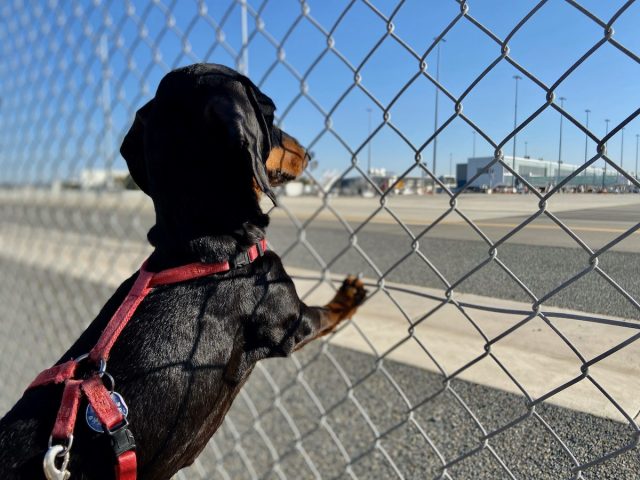
Are Dogs Allowed to Fly in the Cabin in Australia?
Late in 2021, a major regulation changed for flying with pets in Australia. Previously, dogs were not allowed to travel in the cabin on flights within Australia (as well as to and from Australia), unless they were a recognised service dog. This applied no matter how small your dog was.
However, in December 2021, the Civil Aviation Safety Authority (or CASA) changed the rules so that pets can now fly in the cabin, but only if individual airlines allow it. Unfortunately, as of June 2023, no airline has yet changed their rules to allow pets to travel in the cabin on regular commercial flights in Australia.
It is also likely that this rule change only applies to domestic flights, not flights to or from Australia, with pets not able to travel in the cabin on flights to Australia .
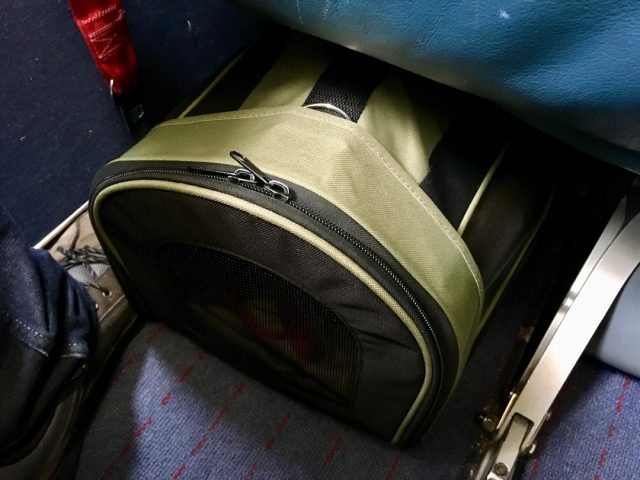
Pet-Friendly Flights in the Cabin to Tasmania
The one instance I’ve come across where pets are allowed to travel in the cabin are on the pet-friendly flights to Tasmania operated by Pawmobile .
Since early 2021, Pawmobile has offered weekly chartered flights from Melbourne (Essendon Airport) to Devonport, along with occasional flights to Hobart. Pets fly in the cabin of the small plane, in their crates, accompanied by an experienced handler.
Note however that human passengers are not accepted at this time, unless you charter the entire plane. Additionally, this is a premium service with prices higher than those for flying pets in the hold – but in return your pet is treated as a passenger, rather than luggage.
Pawmobile also has plans to launch flights to other destinations in the future. For now, connecting road transport from other Australia cities to or from Melbourne can be arranged.
Pets on Regular Commercial Flights in Australia
On regular commercial flights, for now pet dogs and cats can only fly in the hold of airplanes in Australia, generally as cargo. This means that you need to make a booking with the freight division of the airline (or a pet transport company) and drop them off at the cargo terminal. They’re loaded along with cargo into the hold (but with extra care) and then you pick them up at the cargo terminal.
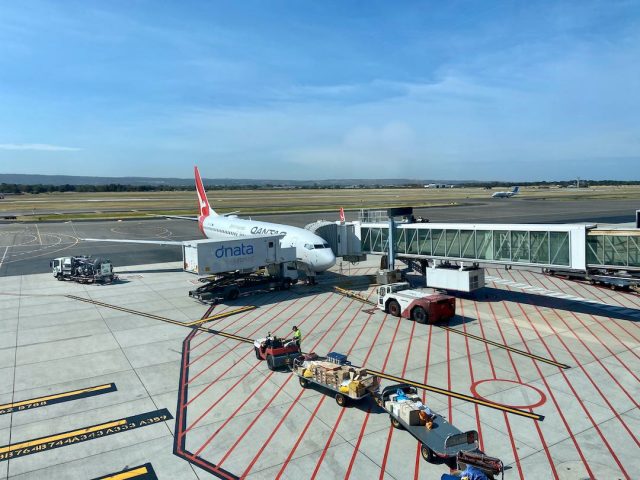
There is also a third way that dogs can fly, as “checked baggage”. This means that they fly in the hold but you drop them off and pick them up inside the terminal, like oversized items. This is generally not possible in Australia, except with Regional Express (REX) on selected routes.
What Airlines Allow Pets to Fly in Australia?
When flying your dog domestically in Australia, there are three main options: Qantas (including Qantaslink), Virgin Australia and Regional Express (REX).
Jetstar, the discount airline run by Qantas, don’t allow pets to fly on its flights. This is the same as many other discount airlines overseas, like Ryanair and Easyjet. This also extends to Qantas codeshare flights operated by Jetstar.
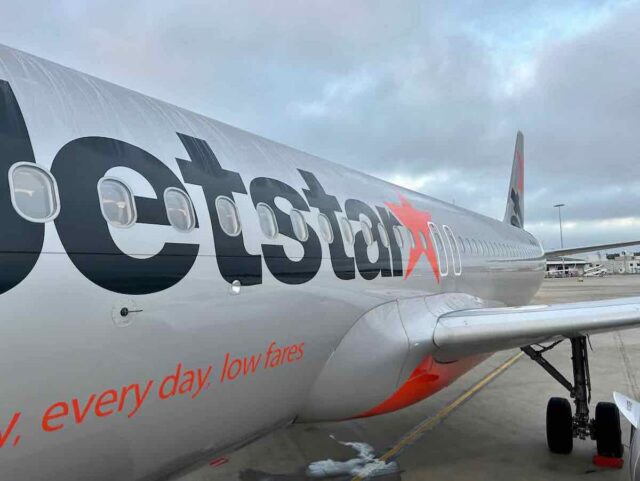
The latest discount airline to launch in Australia, Bonza , also doesn’t fly pets or other animals, other than approved assistance dogs. Interestingly, they include the word “currently” in their FAQ, so maybe this will change in the future.
There’s also a number of small regional airlines that operate in Australia, often just from one airport. Most of these airlines don’t mention whether they transport pets, or just transport pets through Qantas freight.
Flying Pets with Qantas
Pets are allowed to fly on most Qantas flights within Australia. On Qantas flights, pets fly through Qantas Freight , the cargo division of Qantas.
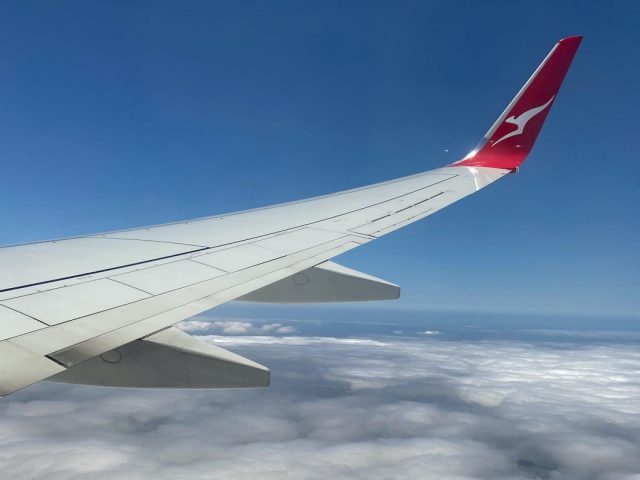
As of June 2023, it is once again possible to make bookings directly with Qantas Freight for pets flying accompanied (on the same flight as you) or unaccompanied (such as a puppy flying to its new home). (For a few years from 2020 to early 2023, bookings were only permitted through one of their preferred pet travel specialists, due to the many flight disruptions.)
Note that pets may not be permitted on some Qantas flights. In particular, there may be some regional airports that don’t have the necessary facilities, or some flights may arrive or depart outside of freight terminal hours.
One other issue that you may encounter if you are flying a larger dog is that some of the smaller planes cannot accommodate the larger size crates. This is unlikely to be an issue if you are flying between the state capitals, but could be the case if you are flying on a Qantaslink flight in or out of a regional area.
Flying Pets with Virgin Australia
Virgin also flies pets within Australia , through their cargo division. Since 2020 they have required all pet bookings to be done through a commercial pet transport company, and this requirement still hasn’t been removed as of June 2023.
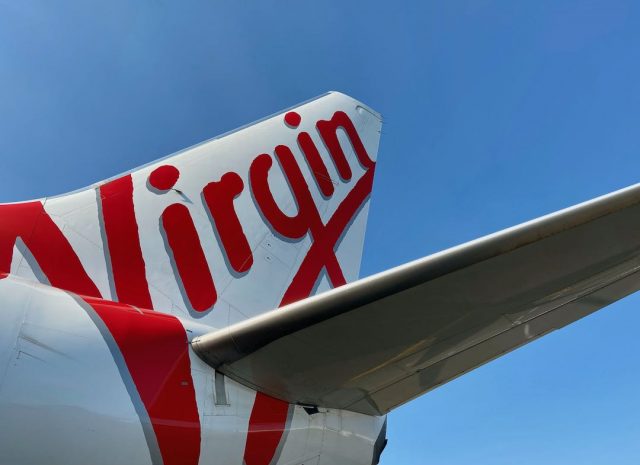
Unlike Qantas, Virgin Australia have a maximum weight limit for flying pets. This is 65kg including your dog’s crate. Additionally, depending on the aircraft operating the flight, larger crates may not be accepted on some flights. See this page for various crates sizes that are or are not permitted on their different aircraft.
There are also some Virgin flights that can’t accept pets on board. In particular, they have a couple of A320s they seem to mainly fly within Western Australia, that don’t have the temperature control necessary for flying pets. They also only fly pets to and from the airports listed here .
Flying Pets with Regional Express (REX)
Regional Express, or REX for short, is a smaller airline that mainly operates flights from capitals and major cities to regional airports. They also fly pets within Australia.
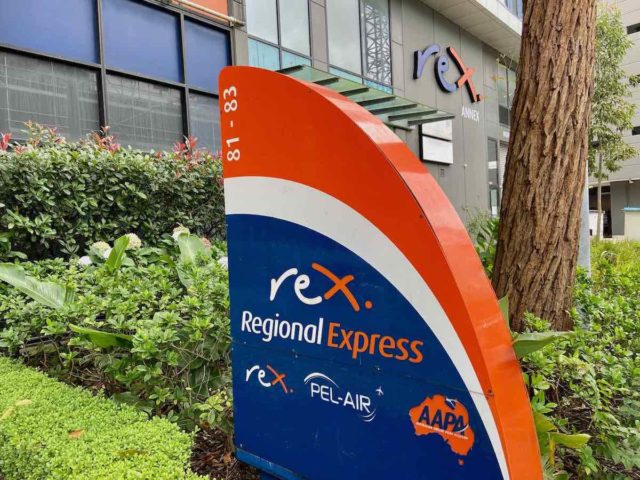
As REX does not have a freight division, they either accept pets as “checked baggage” on some flights, or require other flights to be booked either through Qantas Freight or through a pet transport company.
At the moment, the only pet bookings that can be made directly with REX for carriage as “checked baggage” are regional flights within NSW and Victoria operated by Saab 340 turbo-prop aircraft. For these flights, pets are dropped off at the check-in in their crate and they fly as excess baggage, similar to flying a golf bag.
However, like for all excess baggage, there is a weight and size limit, otherwise your pet must fly as freight. The maximum weight of both your pet and crate is restricted to 30kg. The maximum crate size is restricted to 85cm high x 77cm wide x 131cm long. (And crates often need to be larger than you expect, to meet the IATA guidelines .)
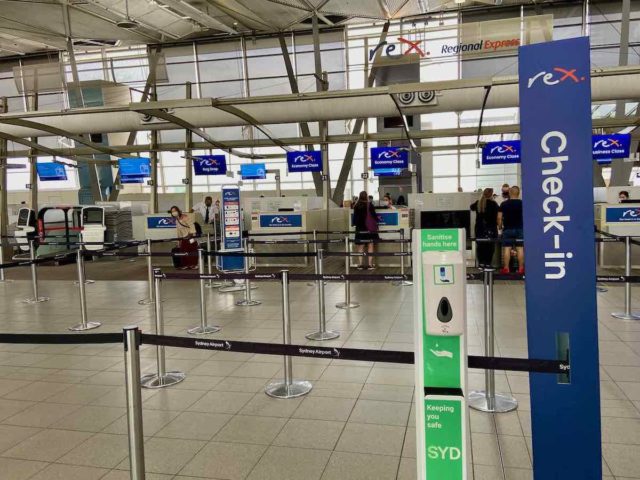
For regional flights in South Australia and Western Australia, you will need to book and lodge your pet with Qantas Freight. This is because both Adelaide and Perth Airports don’t allow animals other than assistance dogs in the terminal.
For regional flights in Queensland, dogs are similarly not allowed in the terminals of Brisbane, Cairns, Gold Cost and Townsville Airports. For pets flying on these flights, you need to book and lodge your pet with Dogtainers , a pet transport company.
Finally, if you want to fly with your pet on the newer Boeing 737-800 jet operated flights between capital cities, you need to contact either Jetpets , Dogtainers or Moorholme Pet Transport.
Are All Dog Breeds Allowed to Fly?
The majority of dog breeds are permitted to fly in Australia, with some conditions.
Flying Dangerous and Strong Dog Breeds
There are a short list of dangerous dog breeds, that are prohibited from being imported into Australia, and are also not allowed to fly at all in Australia (if they are already in the country):
- Fila Brasilerio
- Japanese Tosa
- Dogo Argentino
- American Pit Bull and other Pit Bull Breeds
- Perro de Presa Canario
Other strong dog breeds are permitted to travel as long as they travel in a special non-plastic crates, such as the CR-82 crate or an airline approved guard dog cage. Qantas singles out American Staffordshire Terriers as requiring these crates.
Flying Snub-Nosed or Brachycephalic Breeds
The second main category with special caveats for flying are snub-nosed or brachycephalic breeds, as these breeds are more likely to experience breathing difficulties and heat stress.
Some overseas airlines forbid these breeds from flying in the hold, but both Virgin Australia and Qantas permit them to fly, subject to extra conditions. (REX does not permit brachycephalic breeds to fly either as excess baggage or freight.)
With both Qantas and Virgin Australia, short-nosed breeds can only be booked through an approved pet transport company. The transport companies are aware of the additional regulations that may apply, including being restricted to early morning or evening flights, plus larger crate requirements.
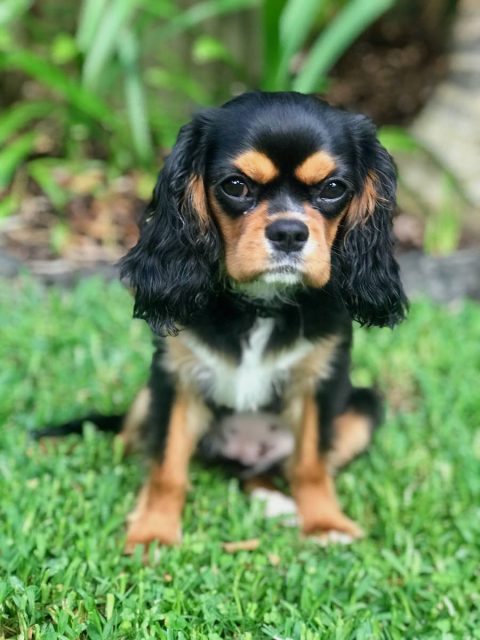
Both Qantas and Virgin have their own list of the affected breeds, with Virgin also including cross-breeds, while Qantas does not. Check the airline specific list.
Previously, when direct bookings were permitted for snub-nosed dogs, it was recommended that you check with your vet about the suitability of your dog travelling by air, plus use a crate one size larger than is standard – Qantas stated a crate twice the usual minimum size. Virgin recommended that snub-nosed dogs over the age of 5 years did not fly, while Qantas recommended snub-nosed dogs didn’t fly above 20C.
Flying Large Dogs
If your dog weighs more than 65kg, including their crate, they may have additional restrictions. At the moment, pets over 65kg cannot be booked with Virgin, plus previously they couldn’t be booked online with Qantas.
With online bookings once again in place with Qantas, the maximum size crate you can book online is 129cm x 62cm x 82cm, although they advise to call up if your pet and their crate weighs more than 50kg. With Rex, the maximum for pets to fly as excess baggage is 30kg.
Flying Puppies and Senior Dogs
Qantas will not fly puppies under the age of 12 weeks (due to the risk of dehydration). While for Virgin Australia, the cut-off is 8 weeks, with puppies between 8 and 12 weeks requiring a vet health certificate. A vet health certificate is also usually required for pets over 12 years old.
Booking Your Pet to Fly in Australia
If you’re flying together with your pet, it’s best to book their flight before making your own flights. There are two main reasons for this: the number of pets that can be accommodated on most flights are limited (sometimes only one or two on smaller planes), plus as detailed above there are some occasions where pets are not permitted at all (such as specific planes, airports and hours of the day).
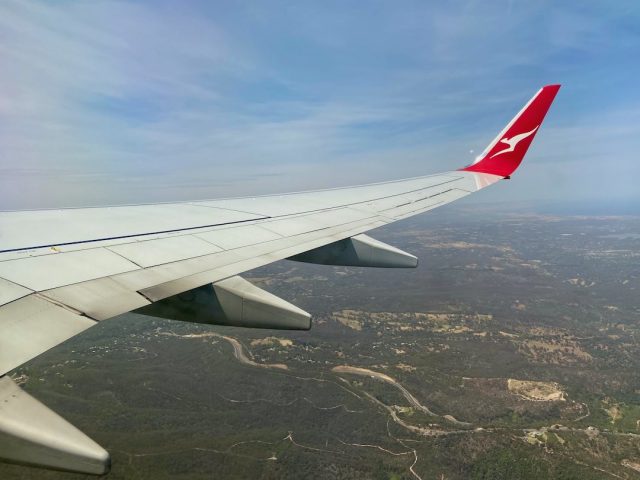
Cancellation and change conditions are also usually quite generous for pet bookings, compared to many human bookings. (For instance, when I flew with Qantas in 2019, pet tickets could be refunded up to 14 days before travel). Additionally, there is usually no variation in the cost of flying pets, even if you are booking last minute.
Note that before you book your pet, you will need to know the size of the crate and the combined weight, as this is used to determine if your pet will fit on the flight plus their ticket cost.
Booking Pets to Fly with Qantas
In the past, I’ve found Qantas the easiest airline to book for my dog, thanks to their online booking portal where you can book pets to fly, as long as your pet plus their crate is no larger than 129cm x 62cm x 82cm (and doesn’t weight more than 50kg combined), and you don’t have a snub-nosed pet. And as of June 2023, you can once again easily book pets online.
When flying with Qantas in the past, after booking our dog’s flight online, we then booked our own tickets online on the regular booking site.
At the moment, you can only make bookings on the Qantas online booking portal up to around three months out. If you are attempting to make a booking for a date that isn’t yet available, call the call centre (13 13 13) to discuss.
Booking Pets to Fly with Virgin Australia
With Virgin Australia, to make a booking for a pet prior to 2020 you instead needed to call their call centre (13 67 89). At least though we could book both our own tickets and our pet’s flight together on the same call, without the usual charge for booking through a call centre.
However, as of June 2023, Virgin Australia is also only accepting bookings through a commercial pet transport company. No direct bookings are currently accepted.
Booking Pets to Fly with REX
If flying with REX and your pet is flying as excess baggage, there seems to be no requirement to book in advance. In particular, the fee calculated for your pet cannot be paid in advance, as it is calculated at check-in.
I would ring and double check in advance that your pet is allowed on your particular flight. Also, if they are flying as excess baggage, there is the chance that if there is no capacity, they will be bumped from the flight.
There is no mention on REX’s website of not allowing direct bookings for pets flying as excess baggage. There is only the list of flights where a booking must be made through a pet transport company or Qantas Freight (or a pet transport company for now).
Cost of Flying Your Pet in Australia
Just as the cost of your own ticket varies depending on how much baggage your choose to purchase, the cost of flying a pet in Australia varies depending on the size or weight of your pet, or more accurately, the size of their crate or the combined weight of your pet and their crate. Additionally, if your pet is flying unaccompanied (you are not on the same flight), the rate is typically higher.
In recent years, the cost to fly with pets within Australia have substantially increased. This is particularly the case if you need to make a booking through a pet transport company, who typically charge a premium (though may include extra services such as pick-up and delivery). Although, hopefully the prices charged by pet transport companies have decreased since the highs during the border closures and flight disruptions of 2020 and 2021.
Cost to Fly Pets with Qantas
With Qantas, the cost to fly a pet is based on their crate size. The cheapest fares are for pets in a XS crate no larger than 48 x 33 x 38 cm. The most expensive fares are for pet in an XL crate up to 129 x 62 x 82 cm. (Note that the labelling of crates has charged since pre-pandemic.)
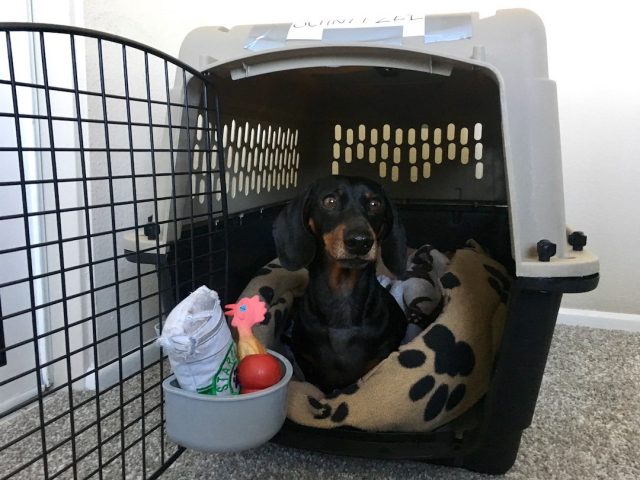
When we flew our dog with us from Adelaide to Sydney in late 2019, his crate fit in the current S category, the second smallest size. His ticket was $137.50, compared to about $140 each for our tickets.
However, the prices are now substantially more expensive. On the online portal in June 2023, I was quoted a price of $292.93 to fly a pet in this size crate from Adelaide to Sydney (with the same price for different dates) – over double the price previously!
Cost to Fly Pets with Virgin Australia
With Virgin Australia, when you could book directly, the ticket price was based on the combined weight of your pet and their crate. The smallest weight category was 1 to 10kg, followed by 11 to 20kg, etc.
When we flew our dog with us from Sydney to Melbourne in late 2019, the total weight was around 10kg. Our dog’s ticket was $95, compared to our tickets which were $117 each.
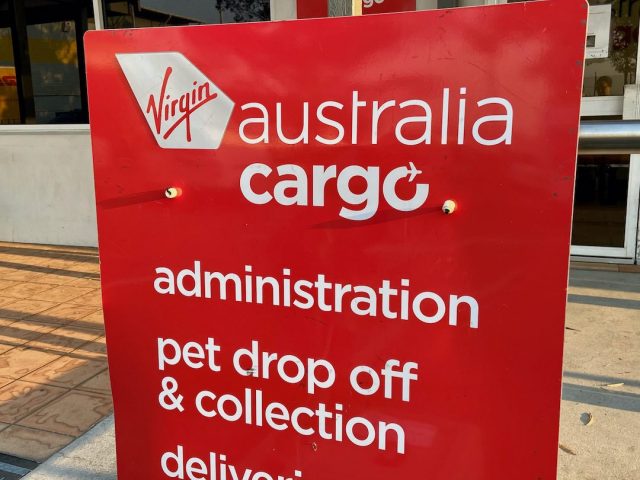
However, at the moment you cannot book pets to fly directly with Virgin Australia, only through a pet transport company, with higher prices charged. And once you can again book directly, the prices will likely increase, as for Qantas.
Cost to Fly Pets with REX
With REX, if your pet is flying as excess baggage, the price of flying your pet is based on the combined weight of your pet and their crate.
The fee is the same as the regular excess baggage charge, currently $5.50 per kilo according to their FAQ , with no charge to this rate in recent years. So, if you are flying a 5kg pet in a 5kg crate, the charge will be $55.00.
Rates for pets flying as cargo with REX likely differ.
Buying a Flight Crate For Your Dog
The biggest step to prepare your pet for their flight is choosing a crate. As I mentioned above, you need to find out the size crate your pet will fly in, plus often its weight, before booking your pet on their flight.
Crate Requirements
There are international guidelines on what size crate your animal should fly in. To determine the ideal size, check out this handy guide on the Qantas website.
Also check out the guidelines listed on the Virgin page for extra requirements, such that two-part plastic containers must have the top and bottom secured by screws or nuts and bolts, rather than plastic clips.
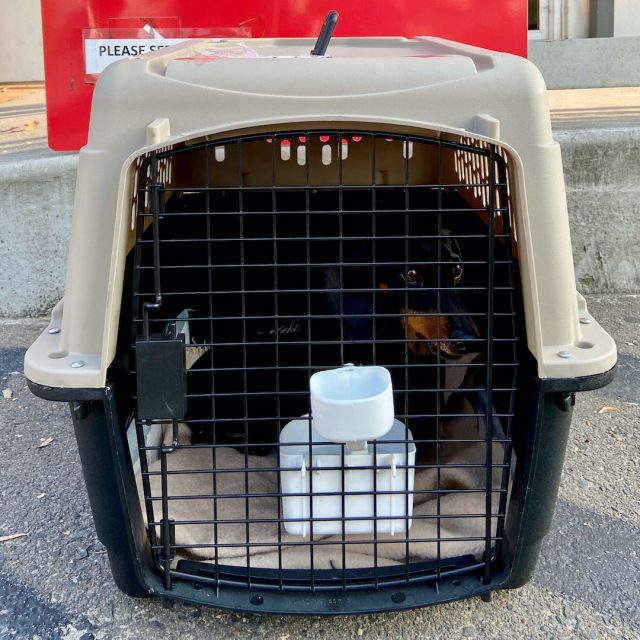
However, I also feel it is best to test out the size of a crate in person, before making the final decision. The guidelines stipulate that there needs to be enough room for your dog to stand, sit and turn around in the crate.
Buying or Hiring a Crate
For this reason, it’s best to visit a large pet store with crates out on display, along with your dog. Qantas also have crates for purchase from selected domestic terminals, that they recommend picking up a few days in advance.
The other alternative to purchasing a crate, especially if you’re just flying a single time with your dog, is to hire a crate. This is possible through some of the pet transport companies that operate in Australia (but only for domestic, not international, flights). It is also possible to purchase a pet crate from these companies.
Familiarising Your Dog with Their Crate
As soon as you get a crate for your dog, familiarise them with the crate. Ideally, they will have been crate trained while a puppy, even if they are now flying in a different crate. Our dog Schnitzel was readily comfortable in his flight crate for this reason.
Encourage them to spend time in their crate, including sleeping. One of the best training methods is to put their bowl at mealtimes in their crate.
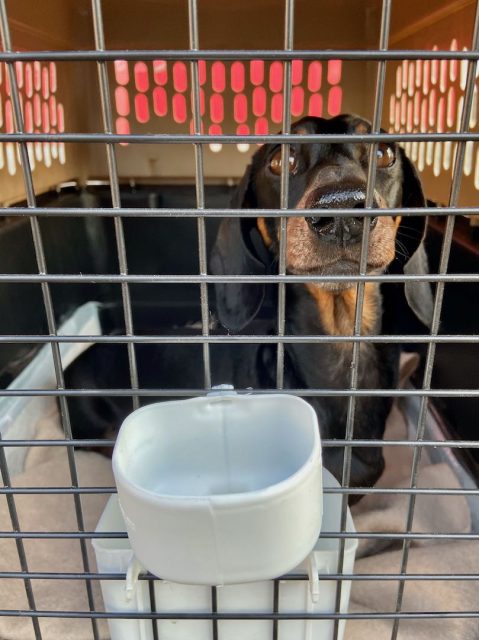
Preparing Your Dog For Their Flight
The biggest step to prepare your pet for their flight is to familiarise them with their crate, as mentioned above. This helps them to be comfortable in it, without stressing, while waiting for and on their flight.
Other steps that you should complete on the day of your pets flight include:
- Take them for a walk , to help tire them out and increase the likelihood that they sleep on the flight
- Only feed them a small meal or snack in the lead-up to their flight, ideally well before the flight.
- Plus toilet them, as close to their flight at possible. I usually do this when dropping off my dog at the freight terminal – most have some nearby grass or gardens.
- Put a water dish in their crate, that can be filled from outside – this is a requirement of air travel. Purchase this at the time you purchase their crate. Fill this up only when dropping off your pet, to minimise spillage. Or consider filling it with ice cubes, that will gradually melt during the flight.
- Put something absorbent in their crate, such as a puppy pee-pad. I usually tape this to the bottom of the crate.
- There are varying recommendations on whether to put anything else in your dog’s crate, but I usually like to add my dog’s favourite blanket, at the back of the crate away from the water dish.
- On the top of your pet’s crate, attach a sheet of paper with key details : your pet’s name, your own name and contact phone number, the Airway bill number.
- Don’t leave your pet’s collar, harness or leash attached when they are in the crate, as there is a risk these could be snagged and cause an injury (or worse) to your pet, while they are unattended in the plane’s hold. (Virgin Australia actually recommends pets wear their collar, while their leash is attached to the outside by zip-ties.)
Note that while many people consider sedating their pets, this is not recommended, unless your vet has specifically recommended it and has supplied a vet certificate (check with the airline first). The reason for this is that pets are more likely to experience breathing difficulties or other issues when they have been sedated, and actually are at greater risk.
Dropping Off Your Pet Before Their Flight
If you are making a booking through a pet transport company, as it still required by Virgin Australia, you will likely drop off your pet at the transport company’s office. They can advise you on where to go, the timings required and what they require you to bring along.
Otherwise, pets flying in cargo with a direct booing, generally need to be dropped off between 120 minutes and 90 minutes before your flight is scheduled to depart, although this can vary at some airports and for early morning flights.
You drop off your pet yourself at the relevant cargo office, which can be a fair distant from the passenger terminal (1km or more away), with their location varying between airport and airline.
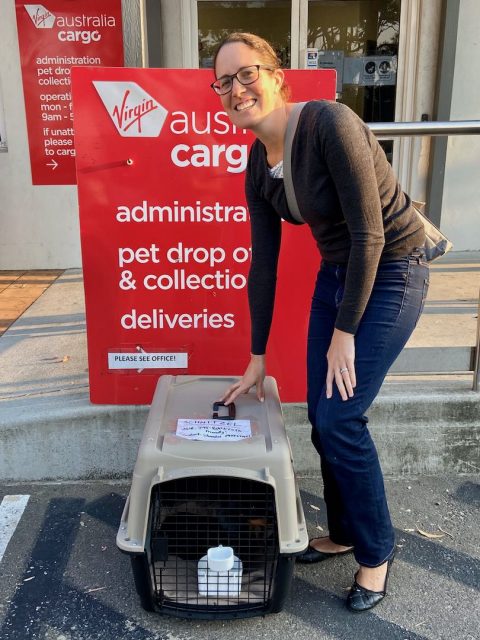
When we dropped off our pet to fly with Virgin when booking directly, we were required to already be checked-in online (and present our boarding pass), plus present the Airway bill number and the completed and printed AVI acceptance checklist (as provided with the booking confirmation).
Qantas has a similar list of requirements. You need to have a copy of your pet’s booking confirmation, photo ID, the completed shipper’s statement and acknowledgement form, and your flight details (e-ticket or boarding pass), if you are flying on the same flight.
When we flew with Qantas, it was okay to have the shipper’s statement on our phone, although we ended up completing the paperwork on a tablet at the terminal instead.
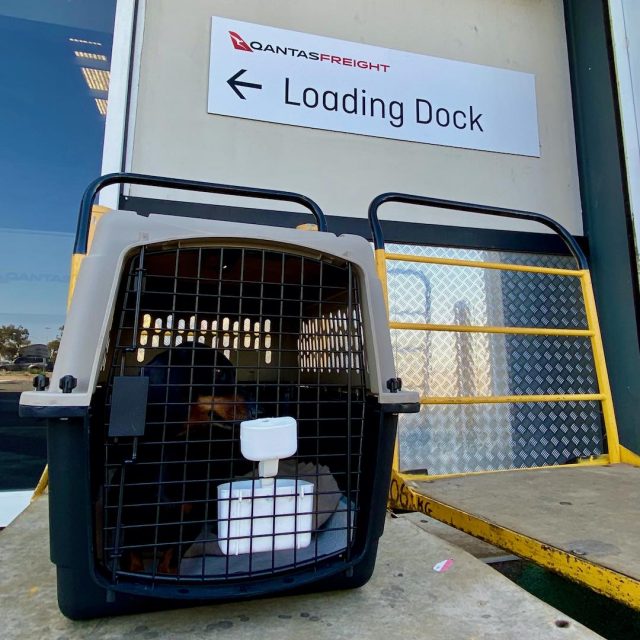
At the freight terminal, they will generally check over your paperwork, get you to sign any extra forms and weigh your pet in their container. Cable ties and stickers will generally be attached to your pet’s crate.
If your pet is flying with excess baggage with REX, the process is simpler. Instead you simply head to the regular check-in counter. However, REX does recommend that you arrive earlier than usual.
Picking Up Your Pet After Their Flight
After your flight, for pets flying as freight and when you have made a direct booking, you pick up your pet at the freight terminal yourself. If you have booked your pet to fly through a pet transport company, check whether you will pick up your pet from their office afterwards or whether you can pick up your pet at the freight terminal yourself.
If flying your pet as excess baggage with REX, you will generally claim your pet from the oversized luggage area, although check with the airport staff if uncertain.
Picking Up Your Pet from a Freight Terminal
Generally, most freight terminals are at a distance from the passenger terminal, although this differs between airports and airlines. For instance, the Qantas freight building at Sydney Airport is only a few hundred metres from where you exit the Qantas domestic terminal, closer than the free pick-up area.

In contrast, at Melbourne Airport when picking up my dog after flying with Virgin I had to proceed to the Menzies Aviation building, about 1km away. I was even required to put on a high-vis vest to enter.
Expect it to take at least 30-40 minutes after the flight arrives before your pet is ready for pick up. Virgin state that it can take up to 30 minutes for your pet to be ready for pick-up. Qantas advise that it generally takes 45 minutes, or 10-20 minutes for regional airports.
Note that you don’t want to leave it too late after the flight’s arrival to pick up your pet. Virgin previously stated that they will only hold your pet for 90 minutes after your flight’s arrival, after which they will contact a local pet care company (at your own expense), to minimise the period your pet spends in their crate.
If you are worried about running late, have the phone number of the freight terminal where you are picking up your pet handy.
What About Using a Pet Transport Company?
Currently, it is a requirement of pets flying with Virgin Australia, snub-nosed pets flying on Qantas, and on many REX flights that they are booked through a pet transport company. But even once this temporary policy is reversed, you may still want to consider using a pet transport company to fly your pet within Australia.
There are a number of reasons why you may want to consider this, including if you are unable to pick up or drop off your pet yourself before or after their flight, or if you’d prefer someone experienced in pet transport to handle the arrangements. A pet transport company may also be able to rent you a crate.
When my dog had to fly from Melbourne to Sydney following his stay in quarantine after flying back into Australia, I booked his transport and flight through Jetpets.
They were able to pick him up from the quarantine facility, drive him to the airport, put him onto the flight, then afterwards we picked him up from the Jetpets office in Sydney. In late 2018, this cost $230, compared to $115 for when he later flew accompanied with a direct booking to Melbourne. (However, note that prices have substantially increased since then.)
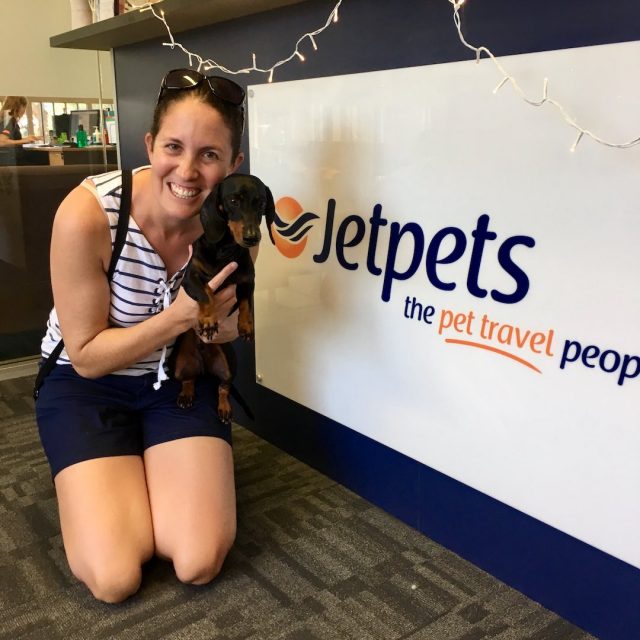
Find out more about whether you should use a pet transport company
My Thoughts on Qantas vs Virgin
I personally didn’t find there was much difference between flying my pet with Qantas or Virgin Australia within Australia in 2019.
In both cases the procedures and steps were similar, although with slight differences. The prices were also fairly similar. The biggest difference between the two was that you could book your pet’s transport with Qantas online, while you needed to call the Virgin call centre to book your pet.
Both experiences went quite smoothly. The biggest possible issue was that there was a heat wave in Adelaide the November day we flew back from Adelaide to Sydney. I called up the Qantas freight call centre a day or two before our flight, to see if I should move my dog onto an earlier flight, and ended up waiting over 30 minutes on hold. (After the wait, I knew why there was an option to press 1 if your pet was flying that day!)
The staff member I spoke to was reassuring (perhaps a little too reassuring!), and we ended up going ahead with the original flight, partially as I know my dog and that it’s fine with warm weather. (He likes to sunbake himself even on hot, sunny days.)
At least with that flight I knew for certain my dog was on it! When flying from Sydney to Melbourne, due to the frequency of the early morning flights between the two cities, I was a little paranoid he may have ended up on the flight before or after. (I should have asked a flight crew member when boarding.)
But when boarding the Qantas flight, the crew member saw my dog’s photo on my phone (where I had the boarding pass), and let me know he was safely onboard, and joked he had been asking for canapes!
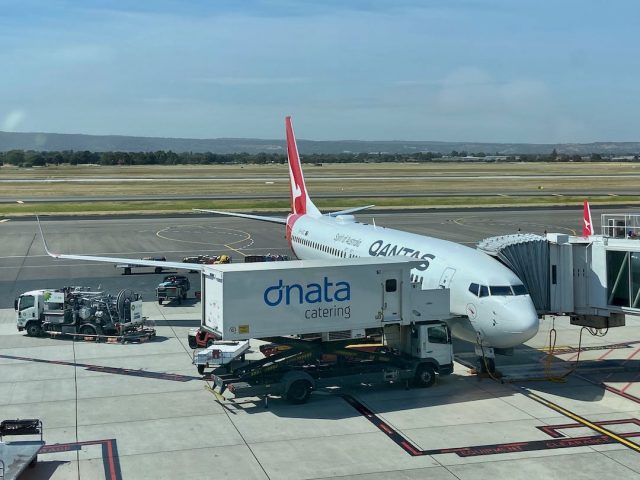
I recommend choosing the airline that you prefer, or that has flights at the best time of the day. During the summer months, plus year round in the tropical parts of Australia, it is best to fly early in the morning or in the evening, to avoid hot weather. If you’re flying with your dog in summer, read my full list of tips .
Unfortunately, I haven’t yet flown with REX, with or without my dog.
You May Also Like
- Travelling in Australia with a Dog
- Can You Fly with a Dog in the Cabin to Australia?
- 7 Top Tips for Flying with Your Dog in Summer
- Which Car Rental Companies in Australia are Pet-Friendly?
About the Author

Shandos Cleaver is the founder of Travelnuity: Dog-Friendly Travel. She has travelled extensively with her Miniature Dachshund, Schnitzel, including to 33 countries across Europe, every state and territory of Australia except Tasmania, and 10 of the United States. She’s passionate about providing inspiration and information to others wanting to travel with their dogs, whether close to home or internationally.
Inspired? Pin this to your Pinterest board!
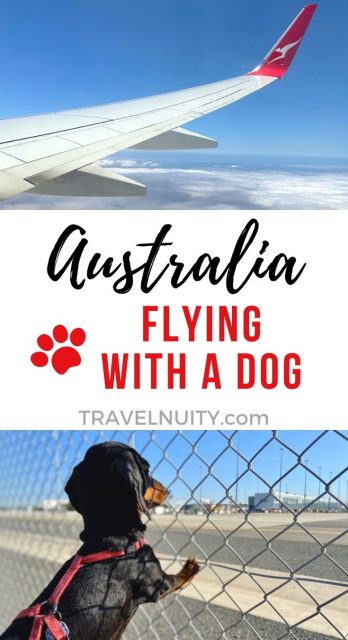
17 thoughts on “Flying with a Dog in Australia: The Ultimate Guide”
Is there a list of prices for flying dogs interstate depending on distance and weight please? I notice Uship supply a range of prices is this the only company that does?
I would contact both Qantas and Virgin directly to find out the prices. These prices change from time to time, plus at the moment with bookings required through a pet transport company the costs are higher.
Thanks so much for this. Very reassuring. I’ve booked my gosh 11 month old Cavoodle to fly from Melbourne to Brisbane in the AM. I was very anxious about how he’d go considering we need to be there at 4am!!
Best of luck with the flight!
May I ask how it went? I’m hoping to fly home with my pup in December, but it all sounds daunting…
35 countries ! How do you get your dog back into Australia? ?
I covered that here: https://www.travelnuity.com/bringing-a-dog-to-australia/
Thank you for creating this article. We would love to take our little sausage with us on short trips within AU, and finding out that this is quite challenging.
The easiest holidays to take with your pup in Australia are car-based trips. There’s a surprisingly number of people completing a Big Lap that have brought their dogs along. Although, hopefully once Covid and the current flight hiccups are past, it’ll become easier to fly with dogs – maybe even in the cabin one day!
Thank you Shandos very very clear advice. It has helped remove the guesswork for our Rex flight from sydney to Griffith on a saab340.
Great to hear, all the best for your flight!
Hi I am trying to book a flight from Brisbane to Adelaide with my JRT. I have flown him before, and this trip usually costs around $350-$400.. when I spoke w Qantas Sn Virgon last week.. the quotes were $1065 and $1124 respectively …..what the hell is going on?.. fyi this is ONE WAY
Wow, that’s crazy! I know prices are higher now than pre-Covid, but I hadn’t seen prices that high for a small dog.
I had a question, I run a nonprofit that gets dogs to open heart surgery. Clearly flying in cargo isn’t a question. If these dogs are US certified service animals can they fly in cabin and avoid 10 day hold? It would not be optimal for a heart dog to go in hold. Also some families want to go to Japan from AUS for surgery, will they be subject to hold and quarantine?
For service dogs, if they meet the requirements of Australian airlines, they can fly in the cabin into Australia on those airlines. I recommend checking directly with the airline. A quarantine period still applies, as long with other paperwork requirements, but I believe there is an option for at home quarantine. It’s not clearly set out on line – but see this page for more info: https://www.travelnuity.com/avoid-pet-quarantine-australia/
For flying out of Australia, recognised service dogs are also allowed to fly in the cabin. Japan only has a very short quarantine period of around 12 hours, as long as all requirements and checks are met. See: https://www.travelnuity.com/what-countries-pet-quarantine/
Thank you so much for such an informative post. My dog is a small toy poodle. He is only 4.5 kilos but 15 years old. I am wondering how to get him to the US. Would the option of taking him on a cruise to Fiji and then fly on an American Airline to Hawaii or LA work? I am just thinking out of the box. I doubt I’ll need to think of bringing him back, considering his age.
If you’re wanting to fly him in the cabin out of Australia, your best option is a shared private jet. Skye Pet Travel ( https://skyepettravel.com.au ) is planning some flights to the USA, although they’re not yet approved and are very expensive. I’ve also heard rumours that Korean Air will fly pets out of Australia in the cabin, but I’m not convinced this is possible – but it’s worthwhile enquiring. Cruise ships don’t usually accept pets on board, so taking a cruise to Fiji isn’t an option, only a private yacht. Sorry about the lack of options!
Leave a Comment Cancel reply
Save my name, email, and website in this browser for the next time I comment.
- Travel Advice
Virgin suspends direct flights from Adelaide to this major hotspot
Virgin Australia has suspend its direct service from this Aussie city to Bali after a delay in the delivery of 10 new Boeing planes.

Swift plane stalker reveals wild details

Aussie‘s hilarious Jetstar clip goes viral

Airline asks passengers to BYO cutlery
Virgin Australia has suspended its direct service from Adelaide to Bali after a delay in the delivery of 10 new Boeing MAX planes.
Travellers keen to head to the hotspot from the Aussie city won’t be able to do so between April 28 and June 9 as the airline awaits the delivery of the new aircraft.

Holiday-makers can still fly from Adelaide to Bali — but will now have a travel time up to 14 hours as the aircraft will have to go via Brisbane, Sydney or Melbourne and transfer to a connecting flight.

Those who have booked a flight during the impacted period will be contacted directly by the airline or their travel agent to provide alternative arrangements or “be offered a full refund”, the airline said.
“We have made the decision to continue suspension of direct Adelaide-Bali services from June 2024 due to various factors including the delayed delivery of new aircraft,” a Virgin Australia spokesperson told enews.com.au.
“We acknowledge this decision will be disappointing for some guests and we sincerely apologise for any inconvenience.
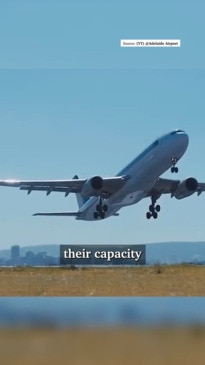
“Guests booked to travel between Adelaide and Bali from June onwards will be directly contacted by Virgin Australia or their travel agent to provide alternative arrangements, including connecting flights to and from Bali on the booked day of travel via Brisbane, Sydney and Melbourne. Where an alternative is not suitable, guests will be offered a full refund.”
More Coverage

News.com.au understands the suspension of the route is to manage impacts to the airline’s international and domestic schedule as a result of the delayed delivery of new aircraft.
“Guests who wish to discuss alternative arrangements available to them, including travelling via an alternate port, are encouraged to reach out to the Virgin Australia Guest Contact Centre on 13 67 89,” the spokesperson continued.
Meanwhile, Jetstar operates up to 14 direct flights a week between Adelaide and Denpasar.
Taylor Swift’s private jet tracker doubled down on releasing flight data, and recently released a YouTube video of all of the star’s flights from 2023.
Jetstar has revealed its new TV ad and an Aussie TikTok star who features in it has shared a hilarious behind-the-scenes clip that’s now gone viral.
A major five-star airline has asked business class passengers whether they would be happy to bring their own cutlery aboard its aircraft.

IMAGES
COMMENTS
Virgin Australia has announced it plans to become the country's first airline to allow pets to ride onboard. Small cats and dogs will be allowed on specific domestic flights with the service ...
And more recent research by Virgin Australia confirmed that 70% of people would travel with their pet in the cabin, and 57% of those said they would fly more regularly if they could take their pet with them. ... Pets must be carried in a Virgin Australia-approved pet carried under the seat in front of the owner for the duration of the flight.
In more recent research conducted by Virgin Australia with Australian pet owners, nearly 70% of respondents advised they would travel with their pet in the cabin, with 57% saying they would fly ...
The announcement that Virgin Australia will soon be letting small animals onto flights has some pet owners excited to bring their furry friends on holidays, and others concerned about health matters.
DOWNLOAD IMAGES . DOWNLOAD OVERLAY VISION. DOWNLOAD AUDIO RELEASE. DOWNLOAD VIDEO NEWS RELEASE (VNR) Thursday 7 March 2024: Virgin Australia has announced its intention to be the country's first airline to operate flights with pets onboard under a plan unveiled today. The Australian-first service, which will have pet-lovers rejoicing around the nation, is subject to regulatory approval, and ...
Virgin Australia has announced its plans to become Australia's first airline to allow pets onboard. You could bring your furry friends on your next flight. Responding to audience feedback from a 2021 survey where almost 70 per cent of respondents said they would travel with their pet in the cabin, Virgin Australia Group chief executive ...
Virgin Australia wants you to be able to bring your pet onboard flights — but at a cost, and under strict conditions. Virgin Australia wants to allow small cats and dogs in the cabin under ...
Virgin. Virgin Australia has announced its plans to allow pets onboard its flights. The new rule will see the airline become the country's first let pets ride in the cabin. "Our love for ...
Summary. Virgin Australia to be first Australian airline to operate pet-friendly flights, pending regulatory approval. Research shows 70% of Australian pet owners would travel with their pets onboard, boosting airline travel. Service will have specific rules: limited to small cats and dogs on designated domestic routes, in approved carriers.
By Lucy Mae Beers. Small pets could soon be allowed to be with their owners in the cabin on certain Virgin Australia flights in a huge change to domestic air travel. Outgoing Virgin Australia CEO Jayne Hrdlicka made the announcement on Thursday morning saying the airline wanted to be the first in the country to introduce the option.
To travel on Virgin Australia, your pet must: Appear to be in good health. Not be unduly aggressive. Be over 8 weeks old. This is due to possible dehydration while travelling. For dogs or cats under 12 weeks old, Virgin Blue recommends you obtain a veterinary certificate, as some breeds are more susceptible to dehydration.
Virgin Pet Travel. Virgin Australia is one of the most reputable airlines in the country and a popular choice for many of our customers looking for domestic pet transport. Domestic Virgin Pet Flights. Virgin domestic pet travel is restricted to only dogs and cats. To use Virgin for pet transport, the airline requests travellers to go through a ...
Virgin Australia has set its sights on becoming the first Australian airline to welcome pets into the cabin, a move that's stirring excitement among pet owners worldwide. This innovative service, subject to regulatory nod, is slated for takeoff within the next year, marking a significant shift in how Australians travel with their beloved pets.
March 7, 2024 - 10:01AM. Passengers who have pets could soon take their furry friends with them on a Virgin Australia flight following the airline's huge new move. On Wednesday, it announced it ...
9:31am Mar 7, 2024. Pets could soon join their owners on the plane under a new plan from Virgin Australia. The airline announced its new policy today, saying it was expected to launch within 12 ...
Virgin Australia is hoping to take the stress out of pet travel with a new initiative - allowing cats and small dogs to fly in the cabin alongside their humans. While the plan is still awaiting regulatory approval, it has the potential to be a game changer for pet owners in Australia. Currently, most airlines restrict pets to cargo holds an ...
Virgin Australia flying with pets What is Virgin Australia policy on pet acceptance? The airline accepts dogs and cats for pet travel on domestic flights.Pets are transported in the cargo hold of the aircraft, except for authorized Assistance Dogs and Guide Dogs, which are permitted to accompany a person with a disability in the cabin.
Virgin AustraliaDeparture Pets relocates pets domestically with Virgin Airlines.At Departure Pets, our team are well equipped to take care of everything associated with your pets relocation; From residence collection to boarding, flight bookings and delivery to their new home - We do it all!Virgin Australia has individual restrictions and requirements for pet travel. Read on for a breakdown of ...
The 3 Most Pet-Friendly Airlines in Australia. 1. Qantas. Check Pet Policy of Qantas. 🐶🐱 Animals Allowed: Cats and dogs through Qantas; other animals through Qantas Freight. ️ Booking Policy: Call to book through a pet travel specialist. Online booking temporarily suspended.
Booking Pets to Fly with Virgin Australia. With Virgin Australia, to make a booking for a pet prior to 2020 you instead needed to call their call centre (13 67 89). At least though we could book both our own tickets and our pet's flight together on the same call, without the usual charge for booking through a call centre.
Virgin pet travel services domestic & international pet transport. Get more information on pet travel costs, quote, booking & more. Contact Dogtainers today!
Virgin Australia hopes to welcome pets into aircraft cabins as early as next year, a move the airline believes will encourage pet owners to travel more frequently. While still subject to regulatory approval, pets would be able to fly in the cabin purely for leisure—not just as assistance animals, as is the case today.
Virgin suspends direct flights from Adelaide to this major hotspot. Virgin Australia has suspend its direct service from this Aussie city to Bali after a delay in the delivery of 10 new Boeing planes.
Pet Travel to a foreign country can be complex and time-consuming. Before you start the process, you will need to know the following: the type of animal traveling, the destination country, the date of departure from the United States, and whether or not the pet will be traveling alone, as cargo, or with a person in the cabin of the plane. ...